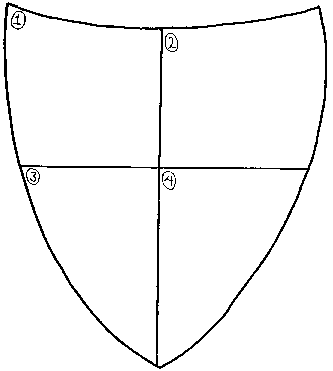
Produced by:
The Farallones Institute Rural Center and CHP International, Inc. in collaboration with
The Peace Corps Energy Project/OPTC
Contract #282-1003
July 1982
Contributors:
Ed Karch
Michael Wilburn
Marsha D. F. Wilburn
Michael Boutette
|
The Peace Corps Internet Web Site address: http://www.peacecorps.gov Please note the new Peace Corps Mailing Address from July 1998 on is: ICE/ Peace Corps 1111 20th Street N.W. Washington, DC 20526 USA |
Preface
Acknowledgments
Introduction
Session format
Training program calendar
Day 1
Session 1: Sharing perceptions of the training program: An ice-breaker
1. Attachment 1-A: Coat of arms
Session 2: Assessing group resources
Session 3: Defining expectations of the training program
Session 4: Introduction to the carbonization process
1. Attachment 4A: Sensory analysis guidance sheet
2. Attachment 4B: The carbonization process
3. Attachment 4C: Sample comparison of charcoal and brands
Session 5: Assessing available wood resources
Session 6: Fire and food: The dynamics of traditional cooking
1. Attachment 6A: Traditional cooking discussion questions
2. Attachment 6B: Fundamental means of heat transfer
Day 2
Session 7: Wood resource management
1. Attachment 7A: Fuelwood production in traditional farming systems
2. Attachment 7B: Why is it so difficult to grow fuelwood?
3. Attachment 7C: Definitions of major wood sources
Session 8: The problem of fuelwood scarcity
1. Attachment 8A: The other energy crisis: Firewood
2. Attachment 8B: Direct energy efficiency of charcoal production
3. Attachment 8C: How the more expensive fuel can be cheaper to use!
4. Attachment 8D: How the more expensive fuel can be cheaper to buy!
5. Attachment 8E: World charcoal use fact sheet
Session 9: Introduction to kiln construction
1. Attachment 9A: Common kiln types
2. Attachment 9B: Basic principles of kiln design
Session 10: Kiln design
Session 11: Kiln construction
Session 12: Nightwatch: Monitoring and extraction
Day 3
Session 13: Review and re-design of kilns
Session 14: Construction and testing of second kiln
Day 4
Session 15: Introduction to presentations
Session 16: Kiln application and innovation
1. Attachment 16A: Design situations
2. Attachment 16B: Realities of making charcoal
Day 5
Session 17: Presentations of kilns
Session 18: Briquetting: A problem-solving activity
1. Attachment 18A: Simple techniques for basic bio-fuels
2. Attachment 18B: Briquetting as a cottage industry: A case study
3. Attachment 18C: Bamako briquettes
4. Attachment 18D: Binders for charcoal briquettes
Day 6
Session 19: Evaluating charcoal yields
1. Attachment 19A: Elementary calculation of moisture content
2. Attachment 19B: Energy potential of raw wood
3. Attachment 19C: Charcoal yield worksheet
Session 20: Program evaluation
Bibliography
This training manual represents one component of a pilot training program in Charcoal Production undertaken by the Farallones Institute and CHP International, Inc. It has been completed in accordance with the terms of Peace Corps Contract #282-1003.
We believe that our involvement has produced a valuable and adaptable learning tool. However, the manual must continue to be tested, evaluated and modified in order to reflect changing needs and circumstances. It is our hope that you will contribute to that process, and that you will help make the manual more appropriate and useful during future training programs.
If you have observations or suggestions about the contents, methods or approach included in the manual, please contact the authors at the Farallones Institute or CHP International, Inc.
There have been many valuable sources of support during the development of this manual. It is only with the help of many people that we have been able to document the various tools and techniques that we have chosen to use in training people to go gently and lightly into the lives of others.
We are grateful to the following individuals for their contributions the development of this manual:
Ada Jo Mann
Howard Raik
Ilios Aditya
Kevin Stewart
Leanne Clement
Andrew Atkeison
Although we cannot mention them all by name, we also thank the many kind people who have contributed by giving us permission to use materials they have developed.
Special thanks are extended to the members of the Farallones community for their continued support, endurance and patience during the evolution of this project.
Finally, perhaps our most important acknowledgment should go to the Peace Corps trainees who have come to learn and, in turn, to teach. It is with them that we have shared our dreams and values. We hope that the tools and techniques they have chosen will serve the world kindly and well.
Basic to the purpose of this training manual is the belief that the process of community development begins when people take an active role in their own education and continues as they identify not only their needs but also the resources, abilities and methods that will help them make decisions and address their problems in ways that are both sustainable and locally appropriate. This belief reaffirms what most of the world's villagers already know inherently: that culture, social systems, politics, religion, economics, and ecology are all threads in the same fabric of community life; and that technology exists only as a tool, a loom upon which all other threads are woven.
An important focus of this training program is the recognition that technical expertise is significant and useful only when it is applied in balance with other abilities. It is of little value for a person to be technically competent without the ability to work cooperatively with others and motivate them toward a more self-reliant and healthy life. For this reason, it is essential that Peace Corps Volunteers develop a variety of complementary skills, knowledge and attitudes that will serve to weave together the many threads of community development.
The training program outlined in this manual emphasizes the parallels which exist between training and Peace Corps service. Throughout the program, participants are encouraged to take a full and active role in their own education and to make decisions that will affect them and the people with whom they work and live. They are urged to cooperate with others, to identify and use the talents and resources that are available, and to practice skills that help motivate people, instill within them a sense of self-confidence, and involve them in the process of their own education.
The training program offers skills training in all stages of the development of technologies related to small-scale charcoal production, including the design, construction, operation, maintenance, repair, and evaluation of prototype kilns. The kiln designs are selected to be as consistent as possible with the realities of rural areas in developing countries.
The program is divided into twenty sessions which occur over a six-day period. Each session consists of a series of activities designed to meet specific training objectives. The objectives of each session are inter-related and linked through association with a number of fundamental themes. These themes serve to guide and shape the development of the skills and qualities necessary during Peace Corps service. Together, the themes illustrate the connection and interdependence between technology and other aspects of community development. The program themes are:
* Development and Transfer of Technical Competence
* Principles and Techniques of Non-Formal Education and Adult Learning
* Methods and Approaches to Problem-Solving
* Development Issues
* Cross-Cultural Perspectives
* The Process of Assessment and Evaluation
The Manual is designed to be responsive to a variety of training situations. Modification and adaptation of the materials is encouraged. However, it is essential to the effectiveness of the training to maintain the integrated nature of the sessions by providing an adequate balance of emphasis among the various themes. This will enable participants to build upon and apply new knowledge in a way that is ordered and meaningful within the context of community development.
The following guidelines have been developed as an aid in transforming this manual into an effective, dynamic training program:
Planning and Preparation
There are many steps that need to occur before the training actually begins. These include defining the scope and approach of the training, identifying staff requirements, locating and establishing a site, and gathering necessary resources and materials.
* Defining the scope and approach of the training:
It is important to carefully read through the entire manual in order to develop an understanding of the overall design and approach of the training program. Sessions are designed to accommodate a maximum of twenty participants. If there are significantly more than twenty participants, some modification of the design of session activities will be necessary.
* Identifying staff and trainers:
The specific number of staff should depend on the particular training situation. As a minimal requirement, there should be at least one primary trainer and one assistant for each twelve participants. The primary trainer should have considerable practical and theoretical experience in charcoal production in developing countries and should be experienced and comfortable with the principles of non-formal education, adult learning, and integrated training. The assistant trainer should be a native of the country in which the training is held and should be experienced in the practical aspects of small-scale charcoal production.
* Locating and establishing a site:
It is best to choose a site that is conducive to experiential learning. It should include adequate room for people to build five to ten miniature kilns, work in small groups, and, if possible, be outdoors during much of the program. There should be a classroom or indoor meeting facilities at the site. It is useful for the training to be held in or near a forest area where local charcoal makers are working.
* Gathering necessary resources and materials:
For the most part, materials and resources will vary with each training situation. Each session includes a recommended list of materials. Be certain that there are enough materials, tools, and other supplies available before the program begins. If some of the suggested items are not available, use ingenuity to find comparable substitutes.;
Conducting the Training
Included here is a list of some considerations that are important to remember in carrying out the program.
* Think small. The miniaturization of kilos is essential to a six-day training program:
The entire process of carbonization must be reduced to a miniature scale in order to bring the process to within the scope of a six-day program. Through miniaturization, all the concepts and principles of carbonization can be demonstrated and practiced using a variety of kiln designs. In order for miniaturization to be successful, it is important to reduce the size of all components and materials proportionately. As an example, a full-size traditional kiln measuring 1 meter x 1 meter x 2 meters using wood that is 1 meter long and 20 cm. in diameter would be reduced to a model kiln, 10 cm. x 10 cm. x 20 cm. Wood used in the kilns should be approximately 2 cm. in diameter and 10 cm. in length. Construction and maintenance of miniatures follow exactly the same procedures as with full-scale kilns. Metal kilns such as the Mark V can be constructed from 20 liter buckets or cans. Using the miniaturization technique, carbonization time for each kiln is reduced to 8 to 10 hours.
* Warning! Charcoal production is a destructive process:
Although it is explicitly brought out in several sessions, the potential ecological impact of charcoal production should be continually reinforced throughout the training. In view of the growing world fuelwood scarcity, and considering that the conversion of wood to charcoal results in 50-80% gross energy loss, charcoal production can, in certain situations, be detrimental to the long-term interests and needs of people everywhere. Stress a general rule for volunteers, that if charcoal is already being made in an area, then working to improve yields can be appropriate.
If wood is in excess and is rotting or being burned, charcoal can be appropriate. But if charcoal is not being used and wood is being burned on open fires, then working to introduce fuel-efficient wood-burning stoves is more appropriate.
* Flexibility and patience are two key requirements for charcoal making:
The participants should be advised of the likelihood of spending lunchtime, suppertime, and late-night hours tending their smoldering kilns. The process of carbonization does not lend itself well to a structured, specified block of time. The type, age, and moisture content of available wood, weather conditions, and kiln design are all variables that can affect completion time.
* The experiential learning cycle is an essential part of training:
It is important that people have the opportunity to learn, examine, generalize about and apply new knowledge. Try to follow the experiential learning loop as often as possible, and encourage the participants to be aware of the process.
* Small groups often make learning easier and more lasting:
It is helpful to limit the size of groups to three, four or five people. Groups may be formed on the basis of regional or country assignments, skill levels, individual preference, or other criteria established by the staff and participants.
* A variety of educational techniques is most effective:
Experiment with role-plays, skits, panel discussions, brainstorming and other non-conventional methods. Encourage people to use their creativity, and to examine which methods have the potential to be useful in community work. As you facilitate sessions, involve people and try to use techniques that others can learn. Remember that as you teach, you will learn. Share your knowledge and motivate others to do the same.
* As the program continues, participants become more responsible for the design and implementation of sessions:
It is a good idea to include people as facilitators in selected activities and sessions. As the participants develop skills and self-confidence, they take an increased responsibility for their own education. Urge people to take an active role in facilitating, planning and evaluating a variety of learning experiences.
* Scheduled breaks between sessions are essential:
Although 10-15 minutes is suggested, more time may be needed, depending on the training circumstances.
Using the Manual
One of the keys to the success of the training program lies in thoroughly understanding and effectively using the manual. Included below are some guidelines and explanations designed to help in using the manual.
* The Program Calendar indicates the overall design of the program and recommended sequence of sessions. Use it as a reference in developing a specific schedule which meets the needs of the particular training situation.
* Sessions follow a consistent format. (See the "Sample Session Format" on Page vi, for a detailed description.) Be certain to read sessions thoroughly. There are often several purposes to each session. For example, the activities may be designed to meet a technical objective, and at the same time, to provide participants with practice in group problem-solving or communication skills. It is important to understand the multi-tiered design of each session before presenting it.
* Attachments follow each session and are usually intended for distribution to the participants. Each attachment is letter-coded as to the session with which it is associated. It is important to make copies of attachments in advance so that they can be distributed during the session.
* The Bibliography includes the reference material, texts, and suggested resources used in developing this program. It can be copied and distributed to participants as the basis for further research in charcoal production.
Each Session is numbered sequentially and coded by day.
Session Title indicates subject area presented.
Total Time gives approximate time needed to carry out the session.
Objectives tell what is expected of participants and what the session should accomplish.
Resources include all attachments and other suggested references.
Materials refers to suggested supplies and tools needed for the session
Procedures consist of steps to be followed in order to meet objectives. Each step is given an approximate time.
Trainer Notes
|
* Appear throughout the session and serve to clarify and explain a procedure, provide background information, and suggest options. |
|
DAY 1 |
DAY 2 |
DAY 3 |
DAY 4 |
DAY 5 |
DAY 6 |
|
|
A.M. |
Session 1: "Sharing Perceptions of the Training Program: an Ice-Breaker" |
Session 7: Wood Resource Management |
x |
Session 15: Introduction to Presentations |
Session 17: Presentations of Kilns |
Session 19: Evaluating Charcoal Yields |
|
Session 2: Assessing Group Resources |
Session 8: The Problem of Fuelwood Scarcity |
Session 20: Program Evaluation |
||||
|
Session 3: Defining Expectations of the Training Program |
||||||
|
P.M. |
Session 4: Introduction to Carbonization |
Session 9: Introduction to Kiln Construction |
Session 13: Review and Redesign of Kilns |
Session 16: Kiln Application and Innovation |
Session 18: Briquetting: A Problem Solving Activity |
x |
|
Session 5: Assessing Wood Resources |
Session 10: Kiln Design |
Session 14: Construction and Testing of Second Kiln |
||||
|
Session 6: Fire and Food: Dynamics of Traditional Cooking |
Session 11: Kiln Construction |
|||||
|
Session 12: Nightwatch - Monitoring and Extraction |
|
Total Time: |
1 hour, 15 minutes |
|
Objectives: |
* To get to know one another and to encourage communication |
|
* To set the climate for active participation during the training program |
|
|
Resources: |
Attachment 1-A, "Coat of Arms" |
|
Materials: |
Pens or pencils. |
|
Procedures: |
|
Trainer Notes This activity is designed to help 15 or fewer participants become better acquainted. If the group is larger and there is a need for learning names, a "name game" should be played first. One game that has been successfully used is as follows: * Trainer begins by giving his/her name preceded or followed by a word which - describes how the trainer is feeling at that moment, and - begins with the same first letter of his/her name (for example, "Mike Motivated" or "Nancy Nervous"). * Moving clockwise around the room, each participant then takes a turn at repeating all the preceding names and describers and adds his/her name to the growing list. * The game ends when all participants have added their names and have tried to repeat the list. |
Step 1. (5 minutes)
Distribute copies of Attachment 1-A, "Coat of Arms" and explain the exercise.
|
Trainer Notes * Explain that the object of the exercise is to draw a symbolic/"coat of arms" which will help us begin to get acquainted or find out something new about each other. * Explain that the participants will draw a symbol or picture in each of the corresponding spaces on the coat of arms that answers one of a series of questions. |
Step 2. (15 minutes)
Referring to the list in the Trainer Notes below, read each question in order, allowing time for people to draw their symbol before moving to the next question.
|
Trainer Notes * Suggested questions: - How do you feel right now? - What were you doing a week ago today? - What do you hope to get out of this training? - What can you offer this training? * Draw your own "coat of arms" while the group does theirs. |
Step 3. ( 5 minutes)
After everyone has finished drawing his/her coat of arms, share your coat of arms by explaining the meaning of each of your four drawings.
|
Trainer Notes Encourage an open climate by explaining your drawings in a relaxed and humorous manner. Also, make your presentation brief to set the pace of the activity. |
Step 4. (30-45 minutes)
Have each participant explain the meaning of his/her coat of arms.
Step 5. (5 minutes)
After all of the drawings have been presented, facilitate a brief discussion of some of the similarities and differences which seem to exist in the group.

|
Total Time: |
1 hour, 30 minutes |
|
Objectives: |
* To identify the skills, knowledge, and experience of participants and trainers |
|
* To discuss ways in which the group's skills and knowledge can be used in this program |
|
|
Materials: |
Newsprint and felt-tip pens. |
Procedures:
Step 1. (5 minutes)
Review the objectives and procedures for the session.
Step 2. (5 minutes)
Ask the participants to briefly discuss the value of a group resource assessment.
|
Trainer Notes Draw on the participants' experiences in working with a variety of people in small-scale development projects. |
Step 3 (10 minutes)
Have the group brainstorm a list of interview questions which could help assess the participants' skills, knowledge and experience.
|
Trainer Notes * To provide focus during the brainstorm, post the key points to be included in the interview: skills, knowledge. * The resulting questions should be consolidated or pared down so that the list does not exceed 4-5 open-ended questions the will stimulate conversation. * In this session, the emphasis is not only on those skills, etc. which relate directly to charcoal-making, but on any resources one might have which would help the group. |
Step 4. (5 minutes)
Post and explain the interview format.
|
Trainer Notes The Interview Format Step 1 (5 minutes) Find someone in the group whom you don't know well and move to a comfortable location. Step 2 (30 minutes/15 minutes per person) Interview one another using the list of questions as guidelines. Jot down brief notes as conversation proceeds. Step 3 (10 minutes) On a clean sheet of paper, write legibly and in paragraph form the information you have gathered from your partner. Step 4 (5 minutes) Share the interview sheets with your partner and make any modifications or additions. Step 5 (10 minutes) Post the sheets on the wall and walk around the room scanning the other interview reports. * If the training group is a small one, an option to the written reports would be to have the pairs interview each other, reconvene the groups, and ask each participant to describe his/her partner. |
Step 5. (60 minutes)
Have the participants carry out the interview procedure.
Step 6. (5 minutes)
Reconvene the group and facilitate a short discussion of the participants' overall impressions of the resources that exist within the group.
|
Trainer Notes During the discussion, point out a number of the identified skills which are particularly useful/necessary to the process of making charcoal. |
|
Total Time: |
1 hour, 15 minutes |
|
Objectives: |
* To review the schedule and content of the program |
|
* To define and clarify expectations that the participants have of the training program |
|
|
* To compare and contrast individual expectations with those of the program. |
|
|
Resources: |
* "Training Philosophy and Methodology," pp. i-ii, from Introduction to the Manual. |
|
* "Conducting the Training," pp. iii-iv, from Introduction to the Manual. |
|
|
* Training Schedule |
|
|
Materials: |
Newsprint and felt-tip pens. |
Procedures:
Step 1. (5 minutes)
Briefly outline the session's objectives and activities.
Step 2. (20 minutes)
Distribute copies of the three resources. Have the participants read them carefully, then ask for questions, clarifications, or discussion.
|
Trainer Notes Explain that the "Training Philosophy and Methodology" and "Conducting the Training" provide an orientation to the overall program goals and design, while the Training Schedule presents a day-by-day description of training. |
Step 3. (15 minutes)
Have the participants form small groups and discuss their expectations of the program. Ask each group to list on newsprint and post their three most important expectations.
* If the training group is small, you may wish to remain together and make a master list of participants' expectations.
Step 4. (25 minutes)
Reconvene the large group and review each expectation for clarity, understanding, and feasibility.
|
Trainer Notes * Identify which expectations will be met directly, those that will be touched upon, those which could be addressed with some schedule changes, and those, given the practical limitations of the program, which may not be met. Identify resources which trainees can use to meet their own needs. * Wherever possible, point out specific sessions in the Training Schedule which deal directly with the group's expectations. |
Step 5. (10 minutes)
Conclude the session by facilitating a discussion centered around the following questions:
* Were any of your expectations changed by this activity?
* Is there anything that you have heard about the training program that has not been discussed?
* Do you think the program will meet your needs?
|
Total Time: |
2 hours |
|
Objectives: |
* To discuss basic fire safety procedures |
|
* To identify the components of an acceptable kiln site |
|
|
* To practice sensory analysis of the carbonization process |
|
|
* To examine and disassemble a sample kiln |
|
|
* To examine and compare types of charcoal |
|
|
Resources: |
* Attachment 4-A: "Sensory Analysis Guidance Sheet" |
|
* Attachment 4-B: "The Carbonization Process" |
|
|
* Attachment 4-C: "Sample Comparison of Charcoal and Brands" |
|
|
Materials: |
Pencils or pens, sample miniatire kiln, assorted samples of charcoal, newsprint and felt-tip pen, 3 or 4 large forks and spoons. |
|
Trainer Notes * This session requires considerable preparation time. It will be necessary to set up a functioning miniature kiln in advance, such that it will be ready to pull during this session. A traditional, rectangular kiln is recommended for this activity. * The kiln site needs to be prepared such that the necessary fire prevention measures are in effect (i.e., clearing the site of all grass and brush, setting up a fire line, etc ) * The assortment of charcoal samples used in this session should be selected on the basis of varying wood species and should include a few sample brands. |
Procedures:
Step 1. (5 minutes)
Explain the session objectives and briefly outline the procedures.
Step 2. (10 minutes)
Briefly explain fire safety procedures on and around the kiln site.
|
Trainer Notes * Mention the following points during your explanation: - the importance of clearing an area of grass and brush - the construction of a protective fire line - the importance of continually monitoring kilns as they burn * Encourage discussion and questions from among the participants. |
Step 3. (10 minutes)
Distribute Attachment 4-A, "Sensory Analysis Guidance Sheet," and ask participants to complete Section A.
|
Trainer Notes * Mention that this initial recording of observations is designed to familiarize participants with their surroundings and help them begin to sharpen their observation skills. * Explain that in completing sections of the "Sensory Analysis Guidance Sheet", participants should write down their observations by concentrating on each of the five senses identified in the left hand column of the page. |
Step 4. (10 minutes)
Have participants share and discuss their observations.
|
Trainer Notes * The following list includes some of the most important observations to be discussed: - season of the year - size of kiln site area - slope of the land - proximity of wood supply - facilities for transporting charcoal - proximity of labor supply - nearby activities that may be disturbed by charcoal making - wind direction * For each key observation mentioned, stimulate discussion by asking participants to explain its importance as a factor in choosing an acceptable kiln site. |
Step 5. (10 minutes)
Ask participants to begin to examine the sample miniature kiln by completing Section B of the "Sensory Analysis Guidance Sheet."
|
Trainer Notes Mention that in making charcoal, the use of the senses is the most common method for gauging the progression of the carbonization reaction. Observation skills through the use of the five senses (i.e., smell, touch, sight, taste, and hearing) should be sharpened through continual practice. |
Step 6. (10 minutes)
Have participants share and discuss their observations.
|
Trainer Notes * The following list includes some of the most important observations which should be discussed: - amount of smoke - color of the smoke - kiln size - kiln shape - materials of which the kiln is made - cracking or popping sounds - the presence of condensates - temperature of kiln and smoke - signs of moisture and condensation * For each key observation mentioned, stimulate discussion by asking participants to explain what it might indicate regarding the design of the kiln and/or the carbonization process going on inside. |
Step 7. (15 minutes)
Ask participants to carefully and slowly disassemble the kiln and record their observations in Section C of the "Sensory Analysis Guidance Sheet."
|
Trainer Notes * Distribute the large forks and spoons to be used as tools in pulling the kiln. * The participants should be encouraged to disassemble the kiln in their own fashion, as long as there is no excessive danger of fire or personal injury. * The focus of the activity is on sharpening the use of the senses. not necessarily on demonstrating the proper kiln |
Step 8. (15 minutes)
Have participants share and discuss their observations.
|
Trainer Notes * Ask participants to point out similarities and differences among their observations at this point and those that they had prior to disassembling the kiln. * For each key observation mentioned, stimulate discussion by asking participants to explain what it might indicate regarding the design of the kiln, the carbonization process, and the type of charcoal found inside. |
Step 9. (10 minutes)
Distribute and explain Attachment 4-B, "The Carbonization Process."
|
Trainer Notes * Explain that this Attachment provides a brief overview of the carbonization process and is meant to serve as a technical summary of the concepts discussed up to this Point. * Encourage questions and comments among the participants. * Ask participants to review it carefully prior to beginning Session Nine, "Introduction to Kiln Construction." |
Step 10. (5 minutes)
Distribute samples of different types of charcoal and brands to each participant and ask them to examine and compare them using their sensory perceptions.
Step 11. (15 minutes)
Distribute Attachment 4-C, "Sample Comparison of Charcoal and Brands" and have participants discuss their observations.
|
Trainer Notes * Some of the most important observations which should be discussed include: - differences between charcoal and brands - color - weight - moisture content - fracturing characteristics * For each key observation mentioned, stimulate discussion by asking participants to explain what it might indicate regarding the type of wood used, the carbonization process involved, the type kiln used, the potential uses for the charcoal, and its relative efficiency. |
Step 12. (5 minutes)
Conclude the session by reviewing the objectives and asking participants to summarize ways in which the senses play a role in charcoal making.
|
SENSE SUBJECT |
Section A: KILN SITE(Surroundings) |
Section B: FUNCTIONING SAMPLE KILN (Undisturbed) |
Section C: DISASSEMBLED KILN |
|
Sight Location Size Shape Color |
|||
|
Hearing |
|||
|
Smell |
|||
|
Taste |
|||
|
Touch Texture Moisture Temperature Density |
Elements of the Combustion Phase
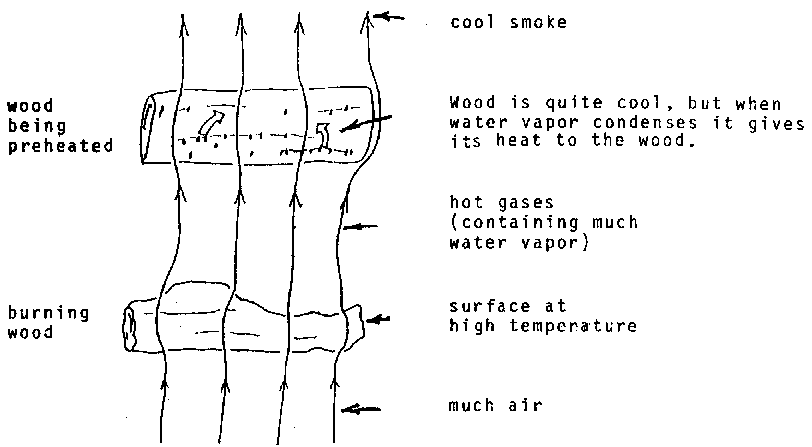
|
Temperature: |
ambient to 600° |
|
Products: |
carbon dioxide, water |
Elements of the Dehydration Phase
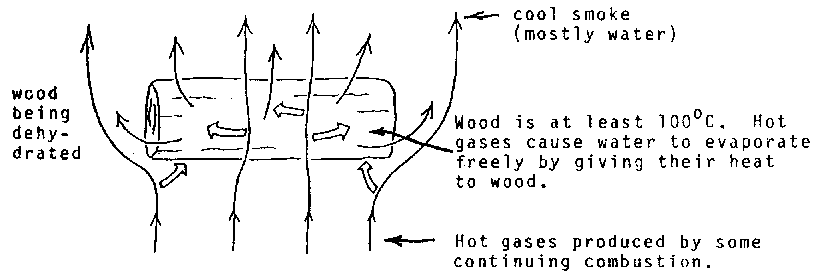
|
Temperature: |
100-120° |
|
Products: |
water |
Elements of the Exothermic Phase

Elements of the Cooling Process
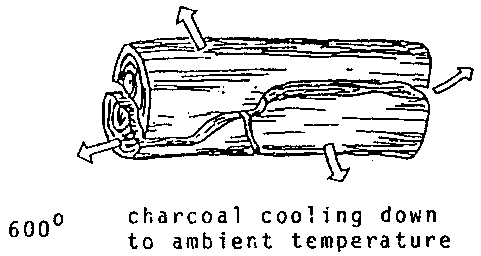
|
CHARCOAL |
QUALITY |
NOT CHARCOAL |
|
Drier |
Moisture |
Wetter |
|
Lighter |
Density |
Heavier |
|
Black |
Color |
Not quite black |
|
Smoother |
Texture |
Rougher |
|
Brittle (weaker) |
Strength |
Resilient (stronger) |
|
Almost none |
Odor |
Definite, pungent |
|
Apparently none |
Coating |
Apparently on surface |
|
High-pitched resonance (metallic ringing) |
Sound |
Lower-pitched resonance ("clunking") |
|
Smoother |
Fracture |
Rougher |
|
Even texture, often shiny |
Surface of break |
Uneven texture from place to place, usually dull |
|
Black through to center |
Color |
Gradations in color visible |
|
Better |
Cleanness |
Worse |
|
More visible |
Growth rings |
Less visible |
|
More open |
Pores |
More filled |
|
Total Time: |
2 hours |
|
Objectives: |
* To identify locally available tree species |
|
* To discuss the characteristics of charcoal produced from local species |
|
|
* To gather and cut the wood to be used during the training program |
|
|
Materials: |
Machetes, approx. 15 - 20 buckets or baskets (20 liter capacity), saws and pruning shears (if available). |
|
Trainer Notes * This session should be held at the kiln construction site. Considerable preparation will be necessary for this session. It will be necessary to investigate the forests surrounding the kiln site and lay out a trail along which a supply of dry, green and rotten wood is available for cutting. The trail should be short enough to be walked in 5-10 minutes. It should be circular, such that it begins and ends at the kiln site. * It is recommended that you invite a local villager to participate in this session by helping to identify local tree species, their common names, and their uses (see Step 2). |
Procedures:
Step 1. (5 minutes)
Explain the session objectives and briefly review the procedures.
Step 2. (20 minutes)
Invite the participants on a tour of the forest area surrounding the kiln construction site along a pre-established trail and begin identifying local tree species.
|
Trainer Notes * As you are walking, ask participants to point out examples of common, local tree species. Stimulate discussion by asking the following questions: - What are the distinguishing characteristics of this species? - What is its common name? - Is it a common variety in your worksite? - What are the most common uses of this species in your worksite? * In discussing the distinguishing characteristics of each species, be sure to emphasize the importance of leaf patterns, bark, and seeds in classifying trees. * Also, during the tour, be sure to point out any particularly accessible sources of wood to be gathered during the next activity. * End the tour by returning to the kiln construction site. |
Step 3. (10 minutes)
Explain the guidelines and procedures for the wood gathering activity.
|
Trainer Notes * Explain that the wood gathered during this activity will be used in the kiln construction activities on Days 2, 3 and 4 of the program. Point out that participants will be making charcoal from a variety of types of wood; therefore, it will be important to gather more than one kind. * Mention that, since participants will be working with miniature kilns all the wood that is gathered should range in sizes up to two centimeters in diameter. * Explain that wood should be cut into manageable lengths and carried or dragged back to the kiln construction site. |
Step 4. (10 minutes)
Explain the specific quantities, varieties, and types of wood that should be gathered and ask participants to determine the most effective method of collecting it in the time available.
|
Trainer Notes * Explain that the training program will require the following: - 8 buckets (20 1.) of 4 varieties of dry wood - 4 buckets (20 1.) of 2 varieties of green wood - 2 buckets (20 1.) of any variety of rotten wood |
Step 5. (20 minutes)
Distribute machetes, saws, and pruning shears to each group, and have them proceed with the wood gathering.
|
Trainer Notes * Before the groups disperse, identify a member of each group that is familiar with the use of the tools and ask him/her to demonstrate their proper use. * As the groups are working, provide suggestions and guidance as needed. |
Step 6. (15 minutes)
When all the wood is gathered, have the groups begin to cut it into the proper lengths.
|
Trainer Notes * Demonstrate the proper length by cutting a few pieces in lengths of between 30 and 35 centimeters. * This work should be done in the shade with groups sitting or kneeling in a circle within easy listening distance of one another. |
Step 7. (15 minutes)
Have a representative from each group explain the type of wood with which they are working and discuss its potential for use in charcoal making.
Trainer Notes
|
* Ask the groups to remain at their work sites, but to stop cutting wood during this discussion. The noise of the saws and the movement can be distracting and would inhibit conversation. * Stimulate discussion and dialogue among the participants by asking the following questions: - What is the relative density of the wood that you are cutting? - What effects, if any, might the wood's density have in determining the kind of charcoal it would produce? - How is this wood most commonly used in your work site? - Do you think that people would use it for making charcoal? |
Step 8. (20 minutes)
Have the participants complete their wood cutting activity.
|
Trainer Notes * Encourage the groups to continue to informally discuss wood species that are common in their work sites and their potential for use in making charcoal. * As groups finish, distribute the storage buckets and explain that it is important to keep all the different types of wood in separate buckets. Each bucket should be labelled (i.e., oak, dry; or Gmelina, green, etc.), for ease of reference later in the program. Green wood should be sealed and protected from the air to prevent drying. |
Step 9. (5 minutes)
Conclude by briefly reviewing the session and explaining that fuelwood use and management will be discussed in more detail in Session 7, "Wood Resource Management" on Day 2.
|
Total Time: |
2 hour |
|
Objectives: |
* To prepare a meal using traditional methods |
|
* To compare the use of firewood and charcoal in meal preparation |
|
|
* To define and discuss the principles of heat transfer |
|
|
Resources: |
* Attachment 6-A, "Traditional Cooking Discussion Questions" |
|
* Attachment 6-B, "Fundamental Means of Heat Transfer" |
|
|
Materials: |
Pens or pencils, assorted traditional pots and utensils for cooking and eating, a traditional charcoal cooker, all necessary ingredients for a traditional meal, machetes, a supply of charcoal, a supply of firewood, kindling, matches. |
* An option to the meal preparation is to have the participants prepare a hot beverage such as tea or coffee using the open fire and charcoal cooker.
Step 1. (5 minutes)
Present the objectives and briefly outline the session procedures.
Step 2. (5 minutes)
Distribute and explain Attachment 6-A, "Traditional Cooking Discussion Questions."
|
Trainer Notes Explain that the questions are designed to provide a focus during the cooking acitivy. Encourage participants to discuss among themselves some of the issues raised by the questions as they are preparing their meal. |
Step 3. (15 minutes)
Have the participants form two groups and prepare two types of traditional cooking fires.
|
Trainer Notes * Ask one group to prepare a traditional open fire using rocks to support the pots and firewood. * Have the other groups prepare a charcoal fire using the traditional charcoal cooker. * Identify those individuals in each group that have had experience with traditional methods of cooking and ask them to assist others in starting the fires. |
Step 4. (10 minutes)
Reconvene the groups and explain the procedures for preparing the meal.
|
Trainer Notes * Point out available pots, utensils, and ingredients for the meal. * Explain that the meal will consist of two basic dishes selected on the basis of their traditional acceptability, ease of preparation, and combined nutritional value. Each work group will prepare one dish using the fire that they have built. |
Step 5. (30 minutes)
Have the participants form their work groups and prepare the meal.
|
Trainer Notes * Identify those individuals in each group that have had experience in preparing similar dishes and ask them to assist others. * Circulate among the groups and provide assistance and suggestions when needed. * Throughout the activity, stimulate discussion by calling participants' attention to relevant points from the list of "Discussion Questions." |
Step 6. (20 minutes)
Have supper.
|
Trainer Notes * As they are eating, encourage participants to informally discuss and share their experiences with the fires. |
Step 7. (15 minutes)
Reconvene the groups. Distribute Attachment 6-B, "Fundamental Means of Heat Transfer" and discuss the three types of heat transfer.
|
Trainer Notes * Ask the participants to define radiation, conduction, and convection. * Encourage participants to refer to their Discussion Questions and illustrate their definitions with examples from their experience with the traditional cooking activity. Ask for examples of where radiant, conductive, and convective heat transfers occurred during the meal preparation. * Briefly discuss ways of slowing down unwanted heat transfer. |
Step 8. (15 minutes) Have the participants compare the charcoal cooker with the open fire in terms of efficiency and ease of preparation.
|
Trainer Notes * Stimulate the discussion by asking the following questions: - Which fire seemed to use more fuel? Why? - Which fire was easiest to manage and maintain? Why? * Encourage participants to refer to the "Discussion Questions" and illustrate their responses with examples from their experience with the cooking activity. |
Step 9. (5 minutes)
Conclude the session by explaining that the complexities involved in determining the relative efficiency of charcoal and firewood will be discussed in more detail in Session 8, "The Problem of Fuelwood Scarcity."
|
Trainer Notes * Before dispersing, ask participants to clean up the work area and thoroughly extinguish all fires. |
Design
What are the major design features of your fire (or charcoal cooker (i.e., draft system, smoke control, baffles, flues, chimneys, construction material, etc.)?
Starting the Fire
- What problems did you encounter in starting the fire?
- How long did it take for your fire to heat up?
- Was there much smoke?
Preparing the Meal
- How often did you need to add fuel?
- Did the fire stay lit?
- Was there much heat loss?
- Did the pots fit well over the fire?
- Once heated, did the dishes hold their heat?
- Was there much smoke?
After the Meal
- Was your fuel source easy to handle?
- Was there much work involved in preparing the fuel for use?
- How long did your fire hold its heat after the meal was prepared?
- How much fuel did you use?

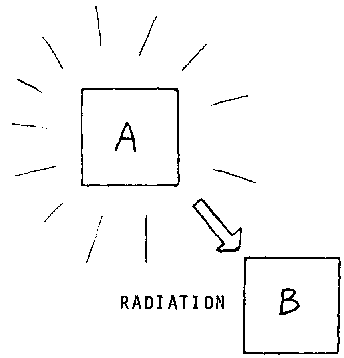
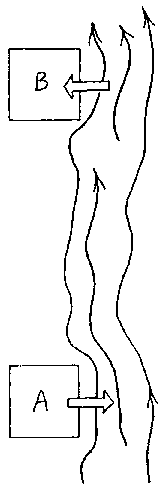
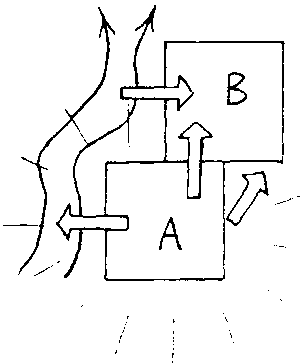
|
Total Time: |
2 hours |
|
Objectives: |
* To list and discuss possible wood sources for carbonization |
|
* To discuss principles of wood resource management |
|
|
* To describe how wood sources can be utilized for making charcoal |
|
|
Resources: |
* Attachment 7-A, "Fuelwood Production in Traditional Farming Systems" |
|
* Attachment 7-B, "Why is it so Difficult to Grow Fuelwood?" |
|
|
* Attachment 7-C, "Definitions of Major Wood Sources" |
|
|
Materials: |
Newsprint and felt-tip pens |
|
Trainer Notes * Prior to this session, prepare on newsprint the following three-column, chart outline: |
|
Wood Sources |
Type of Charcoal |
Potential Use |
Procedures:
Step 1. (5 minutes)
Explain the objectives and briefly outline the session procedures.
Step 2. (15 minutes)
Post the chart outline and have the participants brainstorm a list of possible wood sources for use in making charcoal.
|
Trainer Notes * Record their responses in the left-hand column of the chart. * Some major sources which could be listed include: - plantations - woodlots - mill scrap - logging waste - natural forests - agricultural fallow - land use conversion - agro-forestry |
Step 3. (30 minutes)
Distribute Attachment 7-A, "Fuelwood Production in Traditional Farming Systems," Attachment 7-B, "Why is it so Difficult to Grow Fuelwood?", and Attachment 7 - C, "Definitions of Major Wood Sources" and allow time for reading.
Step 4. (20 minutes)
Ask the participants to identify and discuss some of the major difficulties involved in the management of each of the wood sources listed.
|
Trainer Notes * Stress the importance of citing examples based on their experiences at their work sites and/or based on the issues and examples in the reading material. * Stimulate discussion and the sharing of personal experiences by asking the following questions: - How are wood resources managed at your work site? - What are some of the cultural and economic factors which influence wood resource management at your work site? - What possibilities exist at your work site for better utilization of available wood resources? (i.e., salvage operations, agro-forestry, etc.) - What can you do to help people manage their wood resources? |
Step 5. (15 minutes)
Ask participants to identify and discuss the types of charcoal which could be produced from each of the sources listed.
|
Trainer Notes * List their responses in the middle column of the posted newsprint. * Stimulate discussion by reminding participants of the relationship between wood density and charcoal density discussed during the wood gathering activity. * Ask participants to explain the effects of kiln design on the type of charcoal produced. |
Step 6. (15 minutes)
For each type of charcoal listed, have participants determine whether it would be best for home or industrial use.
|
Trainer Notes * Record their responses in the third column of the posted newsprint. * Stimulate responses and discussion by identifying ideal characteristics of home and industrial use charcoal. |
Step 7. (20 minutes)
Using the completed chart as a reference, ask participants to give specific examples of how wood sources available at their work sites may be utilized in making charcoal.
B. Ben Salem and Tran van Nao
B. Ben Salem and Tran van Nao are members of the FAO Forestry Department. This article is taken from a paper they prepared for the United Nations Conference on New and Renewable Sources of Energy, Nairobi; August, 1981.
The history of fuelwood in the developing world illustrates the dependence of rural communities on forests and trees. Over time, there has been a build-up of fuelwood shortages, with new problems continually arising for rural people in meeting their daily fuelwood requirements. At the same time, environments, under conditions of scarcity, have deteriorated. Should these trends continue, in certain parts of the world the very survival of populations will be in jeopardy.
The reasons for the existence of this situation are well documented. Growing population pressure has usually been recognized as the most important single factor. But whatever the relationship between the trend in human population and increasing fuelwood shortages and environmental deterioration, it must be noted that the relationships among rural forestry, traditional farming activity and the role and potential of rural forestry have for a long time been neglected or ignored. Not only could forestry provide sufficient fuel and other goods and services essential to rural populations, but it could also contribute to stabilizing the foundations of food production systems and to stopping or reversing the impoverishment of the rural environment 35 a whole.
Traditional Farming
Across the world there are fuelwood shortages in precisely those areas that are under the most agricultural pressure. These include all the arid and semi-arid regions under tropical, subtropical and Mediterranean climates, as well as some wetter zones with high population density. The most important features of these areas are the vulnerability of the wood resources and the risk involved in exploiting them because of soil fragility and climatic fluctuations. For both economic and social reasons, the only available energy source for the rural, and part of the urban, populations is organic material, especially wood and charcoal.
Traditional farming systems have often succeeded in integrating activities and in providing a reliable and sustained supply of wood for local needs. A brief description of some of the traditional farming systems illustrates the potential efficiency of rural forestry in a wide range of environments, ranging from the humid to the arid regions.
Traditional Home Gardens
Throughout Southesast Asia (Malaysia, Indonesia, Sri Lanka, Viet Nam, Thailand), on fertile lowlands with high rainfall, traditional home gardens are of fundamental importance in feeding whole populations. In this system, the multi-layered vegetation of the tropics is formed of trees useful to man in providing year-round fruit, food, fodder and fuelwood.
Fuelwood is obtained from pruning, from bamboo and Sesbania wood, and from coconut leaves and shells. For a family of five persons, fuelwood requirements can be met by six coconut palms more than five years old. The traditional home gardens have helped to maintain soil fertility and to provide a reliable source of fuelwood. It has been reported that in East Java, 63 percent of all fuelwood was obtained from farmyards; and that in centeral Java, 49 to 81 percent of all fuelwood came from home gardens. The production in one watershed in central Java was estimated at between 7 and 9 m3/ha/year.
The Combretum-Rice System
In Southeast Asia, in areas with an annual rainfall varying from 1,500 to 2,000 mm over five to six months, the Combretum-rice system is common. Farming activities consist mainly of rice cropping, which is done in the rainy season, but trees have always been planted in conjunction with rice production. Rice fields are demarcated in the form of squares of 1 hectare each by small dikes which are planted with two rows of Combretum quadrangular. Sometimes Calophyllum insophyllum is planted on large dikes to produce seeds from which oil is extracted and used for lighting. Combretum is managed under a coppice system with a rotation of five to six years. This means that each year farmers cut between one fifth and one sixth of the total length of their dikes. Fuelwood production from the first cutting is estimated at between 0.6 and 1.0 m3 per 400 linear metres per year. In the second and third rotations, this production may double.
Bush-Fallow Systems
These are adaptations of the shifting cultivation which occurs extensively in Africa, Asia and Latin America among subsistence farmers to reconstitute soil fertility and to supply rural people with fuelwood, fodder and minor forest products. A number of bush-fallow systems are of particular interest.
The gum arabic tree-fallow system has long been used in regenerating soil fertility over large areas, particularly in Kordofan and Dar fur provinces and parts of the Blue Nile and Kanala provinces in the Sudan. In this system, crops are grown and gum is produced in a well-defined rotation.
In Kurdistan and in the Zagros mountains of Iran, the local people use a system which involves the exploitation of natural scrub and bush for fuel. After exploitation, the land is plowed and cultivated with barley. Then, after only one crop is harvested, it is left to fallow for three to five years to allow the natural vegetation to re-establish itself. Total fuelwood production from the vegetated part may be estimated at 15 to 25 m3 for the fallow period of about five years.
In southern Iran, farmers practicing irrigated agriculture deliberately plant crops of Tamarix spp. around their fields to protect vegetable crops. When the land is abandoned after the well water becomes salty, they plant tamarisk trees to reduce soil salinity before moving to another piece of land. This, in addition to fuelwood, produces sticks for their vegetable crops. After three to four years, the trees are dug up and both roots and aerial parts are used for fuelwood. On the basis of 200 trees/ha. between 4.7 and 6.5 m3 of fuelwood could be collected after four years, in addition to between 0.8 and 1.2 m3 of roots.
Legume-Tree Food Crops
This system has been used over a considerable area in semiarid ecosystems where soil fertility and moisture availability are limiting factors to food crops. Dwellers in these zones encourage the regeneration and growing of the trees to maintain soil fertility and to produce fodder and fuelwood.
Shade-Tree Industrial Crops
Use of shade trees for industrial crops (coffee, cacao, pepper and tea) is well documented. In Sri Lanka, Clyricida spp. provide live support stakes for pepper vines or shade trees for tea plantations. An appropriate pruning operation can yield a limited amount of fuelwood each year. Although this yield may be small on a hectare basis, the potential contribution is large in view of the total area devoted to combination tea and pepper plantations in the tropics.
Trees planted in shelterbelts and windbreaks to improve local microclimates and to enhance the quantity and quality of crop yields are used in the agriculture of many countries as environmentally effective hedges. Apart from its effect on crop production, the system also provides cash crops and a substantial amount of fuelwood.
Other examples of rural forestry could also be cited. All show a variety of forestry practices and successful adaptations to meet fuelwood requirements. There are, however, a number of features which distinguish them from classical plantation forestry. First, fuelwood products in farming communities are from a variety of ligneous material and come from a wide range of woody species. Farmers will often plant not one but several species, often multipurpose species, to cover a variety of specific economic and ecological needs. Another important characteristic in fuelwood production is the selection and planting of only those species that provide food, fodder or income directly, or assist in the production and sustenance of these items by maintaining and improving soil fertility. In the subsistence economies, fuelwood was often regarded in the past as a by-product of the efforts to produce enough food for the family.
A third feature of farming communities is their relatively low consumption of fuelwood. Subsistence farmers have traditionally kept their fuelwood requirements in harmony with their actual needs. The practices described above suggest that under such conditions, where land is not scarce and where peasant communities are able to produce their own food and to integrate trees into their land-use systems, immediate and long-term requirements for fuelwood can be ensured. For a number of decades, however, this system has been under increasing pressure from a number of separate and related causes originating not so much in technical factors as in the land-use system itself. Early attempts to improve subsistence agricultural systems emphasized annual cash crops. The extensive cultivation required by such crops reduced the tree cover and exhausted soil fertility. Trees no longer improved soil fertility through nutrient recycling and humus supply, so commercial fertilizers had to be used. Although they were partly successful, they increased farmer dependence. Another factor was the intensification of livestock grazing without due regard to fodder production, which led to greater pressure on available woody resources and to the shrinkage of woody grazing grounds.
With the advance of large rural settlements and the expansion of cities, fuelwood, which used to be a free commodity, entered the market and was traded not only for cooking and heating purposes but also for a variety of artisanal and industrial uses such as brick and lime making, tanning, ceramics and pottery, brewing and food additives. This resulted in a rapid decline of fuelwood resources. Peasant communities found themselves with rising shortages which forced them to search farther and farther afield in order to meet their needs.
Potential and Limits of Rural Forestry
The previous discussion strongly implies that rural forestry is the most natural solution to the problem of fuel in the rural areas, and the' trees and forest vegetation can be integrated in the traditional land-use system in a variety of ways. Finally, it clearly demonstrates that such integration is not mere coincidence but the result of well-thought-out systems designed to improve subsistence food production and to control land degradation.
These conclusions have important policy implications in relation to fuelwood production. They suggest a need to re-examine past plantation models, which have been based essentially on intervention in the forest domain and in the so-called wastelands. A concept of forestry is required which will spread across the whole spectrum of land management. The agricultural sector, for instance, ought to include forest trees. Here, their role would be to support agricultural production, diversify income and control land degradation.
Between 2 and 5 percent of agricultural land can be opened up for tree plantations according to various tree-planting patterns without any loss to agricultural production. This could have a great impact on the basic problems of food and land amelioration while providing the necessary fuelwood in the rural sector.
The implementation of this policy will require a program to improve and/or introduce traditional forestry in agricultural communities. It will require the development of a number of technical solutions associated with the integration of tree growing and farming. It will also require that forestry that is now largely production-oriented must become oriented as well to agricultural improvement. Fuelwood and fodder production would then become the two most important products. This would require a much more intimate knowledge of the tree species best adapted to the region and the people, but it would not eliminate the need for developing, through genetic selection, fast-growing strains of local and exotic species which are relatively unaffected by local pests, diseases and biotic factors. Nor would it eliminate the need for developing silvicultural systems adapted to different levels of rural production systems.
The Socio-Economic Framework
Before we can expect any success in the implementation of such a program, the previous socio-economic framework, which has brought about the over-exploitation of trees on agricultural lands, will need to be fully understood. What will readily work in one region, for example, will not work in others. In some areas, trees and shrubs could be introduced without upsetting the local economy because of large holdings or because of the existence of intensive agriculture. In other areas, this would not be possible because land holdings are too small and people are dependent on them for food. In uplands with small farming communities, trees could not be introduced without assistance to those now dependent on plant cover for part, if not all, of their livelihood.
If traditional forestry practices are to become an integral part of rural planning, farmers will have to be the object of special information campaigns and will have to be trained in tree planting and management. This can be done either individually or collectively. First of all, the political authorities will have to recognize that this integration of forestry and agriculture is becoming more urgent all the time because of the combination of increasing population and shortage of wood for man's most basic needs, especially fuel.
Matching the trees to the appropriate systems of agriculture - some examples
|
Species |
System wherein the species is found (or associated with) |
Fuelwood |
Timber |
Light farm wood |
Other uses |
Method of propagation |
Annual rainfall and climatic/soils conditions |
|
1. Acacia arabica |
Windbreaks Shade trees Bush-fallow |
xx |
x |
Pods as fodder |
Direct seeding on mounds, strip or line |
Alluvial or loamy soil; moist conditions |
|
|
2. Albizia falcataria |
Shade trees Regular planting in farm forestry |
xx |
xx |
x |
Direct seeding or seedlings raised in nursery |
Wide range of soils but prefer loamy soil and good rainfall |
|
|
3. Bamboo (several spp.) |
Live fencing Regular plantations in farm forestry Around houses |
x |
x |
xx |
Raw material for cottage industries Shoots for food |
Rarely from seeds Shoot cuttings |
Loamy or clayey soil; moderate to high rainfall |
|
4. Calophyllum inophyllum |
Shade trees for amenity (roadsides, around houses, public gardens) |
xx |
Burning oil |
Seedlings to be raised in nursery |
Loamy/clayey soil; moderate to very moist conditions |
||
|
5. Cassia siamea |
Shade trees in plantations |
xx |
x |
Direct sowing of seed in lines |
Heavy rainfall (poor growth in dry climate) |
||
|
6. Casuarina equisetifolia |
Agri-forestry systems Windbreaks |
xx |
xx |
x |
Tannin bark |
Seedlings raised in nursery. Planting (1.5 to 2 m spacing) or if too close early thinning needed |
Sandy soil; stand rainfall between 800 and 5 000 mm |
|
7. Combretum quadrangulare |
Rice field dikes |
xx |
x |
Medicine |
Seedlings raised in nursery. Direct seeding possible |
Loamy soil; slower growth on sandy soil; average rainfall 1500-2000 mm over 5/6 months |
|
|
8. Cordia alliodora |
Agri-forestry systems Shade trees in coffee plantations |
xx |
x |
Direct seeding (mixing success). Seedlings from nursery - wide spacing (unless early thinning). Natural regeneration good |
Moist, well-drained sites; rainfall 1500-2000 mm |
||
|
9. Gliricidia spp. |
Shade trees in plantations or as living stakes |
x |
x |
Direct seeding or stumps |
Alluvial or clayey soil; high rainfall or moist conditions |
||
|
10. Grevillea robusta |
Shade trees in tea and coffee plantations Roadside trees |
xx |
Seedlings from nursery |
Sandy soils; 700 to 1500 mm summer rainfall |
|||
|
11. Leucaena glauca |
Windbreaks Shade trees Planting around houses |
xx |
x |
Fodder Green manure Nitrogen fixing |
Direct seeding or cuttings |
Neutral or alkaline soils; poor growth on acidic soil; rainfall 600-1700 mm |
|
|
12. Morus Indica (M. alba) |
Regular plantations for silkworm raising Irrigated roadside or canal planting |
x |
x |
Fruit leaves for silkworm raising |
Direct seeding or branch cuttings |
Light sandy soil. Moderate to high rainfall 600-1700 mm |
|
|
13. Pithecolobieum saman |
Shade/amenity trees |
xx |
x |
Fodder Medicine |
Direct seeding or seedlings from nursery |
Clayey or loamy soil; high rainfall; moist conditions |
|
|
14. Prosopis spp. |
Plantations for fuelwood Bush-fallow |
xx |
x |
Fodder |
Direct seeding (if irrigated or stump planting |
Dry soil, not excesive moisture; grows on rocky and saline soils |
Raymond Noronha
Raymond Noronha is a sociologist on the staff of the World Bank.
For a large part of the world's population, wood is the main source of energy for cooking, heating and all kinds of local manufacturing. But the forests that produce this wood are under increasingly heavy pressure. This gives impetus to the necessity of looking to village woodlots as one of the most important means of dealing with the wood-energy crisis.
Two basic assumptions should be made: first, that the techniques of establishing woodlots are well known; second, that trees serve a variety of human needs and are one of the cheapest sources of energy. If there is no dispute about these assumptions, why is it that village woodlots are not springing up all over the countryside in the developing countries where they are so badly needed? The reasons are not technological, but social and political.
Examples of both successful and unsuccessful woodlot programs are few, and relatively recent: China, the Republic of Korea, India (Gujaret), Tanzania and Niger. However, all of these have been subjected to intensive scrutiny.
China
Over a period of 30 years, from 1949 to 1978, the forest area of China increased by 72 million hectares, representing 12.7 percent of the land area. The main cause of this increase was the mass mobilization of rural communities. National targets were set and then translated into specific goals for districts, brigades and communities. The revolutionary spirit pervading the program, as in all other Chinese programs, called for rebuilding and renewal. The organization for this purpose already existed; the division of tasks was prescribed uniformly throughout the nation and implemented by a hierarchy of officials and cadres.
Republic of Korea
The Korean example, which has been more highly touted than the Chinese as a model for other developing countries, seems more dramatic. Until 1973, all efforts at controlling forest degradation had failed, and seedlings planted by foresters were cut within six months of planting. Since the villagers traditionally regarded forest land as a free source of fuelwood, the result was a loss of forests around communities and the increasing use of leaves, grass, rice straw, maize stover and other agricultural residues for fuel.
The Republic of Korea embarked on a four-fold program in 1973 which involved the strengthening of the Forest Department, the passing of the new Forest Law, and the launching of an extension and public information campaign. This gave encouragement to the planting of trees, to conservation measures and to enforcement of the new law. The prohibition of leaf-raking and removal of grass litter within forest areas was enforced and a national reforestation scheme was started to create fuelwood plantations in every village.
India (Gujarat)
The story in Gujarat is slightly different. By 1969, it was realized that the reserved State forest areas were dwindling through constant incursions by the rural population for their fuel, fodder, and building-pole needs. Further, the rural population was increasingly compelled to use agricultural residues and dung for fuel, thereby affecting agricultural returns. The two principles used by the Forest Department in trying to reverse this trend were, first, to provide a demonstration effect--to show people that trees could be grown with profit and for comparatively quick returns; and second, to conduct an extensive public information campaign. In implementing the former, the Government was induced to hand over responsibility for road and canal sides to the Forest Department, which planted trees there.
While the program of planting on government lands and encouraging individual tree-planting could be described as a runaway success, the village woodlot program is lagging. Starting in 1974, the Forest Department decided to get village panchayats, or locally elected bodies, involved in reforestation on village commons. The approach differs significantly from that of the Republic of Korea. The Department requests the village to set aside a portion of its lands for reforestation and undertakes all the work of establishment, maintenance and protection. These are now called "supervised" village plantations. At harvest, the village receives half of the net sale proceeds.
In addition, there are self-help village plantations where the Forest Department provides only free seedlings and technical assistance. To date, there are only 2,500 supervised, and about 70 self-help village plantations, representing about 14 percent of the villages in the State. Although Forest Department officials plan to increase their efforts to convince more panchayats to undertake community woodlot plantations, it would appear that their efforts will not be as successful as in the promotion of individual forestry.
Tanzania
Village woodlots in Tanzania have also not been entirely a success. The program, however, is relatively recent, having begun only in 1975. The organization and process of decision-making closely parallel those of the Republic of Korea. The basic unit, in an ujamaa village, is the village assembly which elects a council and a leader who is also the party secretary. In addition to working their own plots, villagers have to provide communal labor. Program formulation originates at the village level and then proceeds to the ward, division, district and region. At the village level, the village adviser, who is also the manager, is a government-appointed official. This framework allows for planning and decision-making directly at the village level. Although there is an inter-linking of government and elected personnel at every level up to the regional, together with provision for participation by the people, the village woodlot program has yet to achieve anything like the success of the Korean and Chinese programs.
Niger
Even less of a success was the effort to establish 500 hectares of village woodlots in Niger under a World Bank project. "As fast as the trees were planted," said one observer, "the village people either pulled them out or allowed uncontrolled grazing to take place." Of another village woodlot program in Niger, this one funded by CIDA, it was said that "effective local participation in reforestation has been throttled by an exclusive reliance...on a community woodlot system ill-suited in the socio-political context to serve as a vehicle for reforestation efforts..."
Social Factors
What are the reasons for the successes and failures of the programs described above? Are there any principles to be extracted from them that can be usefully applied to future village woodlot projects, or is each case, as is sometimes suggested, unique, with no possibility of relating the experiences of one project to another?
First, the Korean village is homogenous; it is not segmented by caste or tribal affiliations. Though disparities in wealth exist, they are not great. There is, therefore, a relative equality among all villagers. Second, as in the Chinese program, there is government commitment to the establishment of village plantations. This commitment takes the form of budgetary assistance, technical expertise, public education and law enforcement. It is not difficult, in these circumstances, to "convince" the landowner to part with his forest land for a return of 10 percent of the proceeds from growing trees. It is also not difficult to persuade the villager to perform his share of community duties when failure to do so would incur penalties enforceable by his village peers. Third, the "Samaeul Udong" movement, which worked in other spheres of village activity, was successfully integrated into the reforestation movement. Fourth, the organizational format reaches down to the village and provides a forum for expression, even though needs and projects are finally determined at the country level.
Gujarat presents an interesting contrast in that while individual planting has expanded, village woodlots lag. Why is this so? Based on my recent visits there and to Uttar Pradesh, I can try to offer some reasons. First, the Indian village, unlike the Korean, is heterogeneous. There is a mosaic of casts which associate only on well-recognized traditional occasions such as temple festivals. On a few other occasions, such as weddings, some castes do act in common, but only within a traditionally defined role. There is no tradition of communal action for such projects as growing trees.
In one village where community woodlots did take hold, dynamic leadership was responsible. A trusted panchayat chairman started by planting trees on his own land and then convinced the villagers that they, too, should have their own woodlot. Why did he decide on a self-help scheme rather than one in which the Forest Department would do everything for him? "Because," he said, "I refuse to pay the Department 50 percent of the profits for work on our land which is, in any event an overpayment." Where did he get funds, since his panchayat was poor? "People trust me. When I need money I approach rich villagers who give me anything I ask for."
A second key factor for village woodlots is the availability of land. There must be enough agricultural land for the local community. The village commons should be large enough so that villagers do not feel that reserving land for forestry will affect their other needs, particularly grazing. Also, the area set aside should be large enough for the harvest to meet the needs of all villagers. The percentage of villages capable of satisfying all of these conditions is small.
Third, governmental support for the program is essential. In Gujarat, while there is complete support for the forestry program, support does not appear to be as wholehearted for the village community woodlot program.
A fourth point is that Gujarat, like the Republic of Korea, has made the transition from individual initiators to a flexible organization that retains the spirit of the initiator with the addition of an extension network which reaches down to the village. Sociologically, it might be said to have made the transition from charismatic leadership to bureaucracy.
Fifth, labor for plantations and maintenance continues to be a problem, since there is little available locally and most has to be supplied by migrant tribes. Local workers are usually tied to contractors or bound by social and economic ties to landowners who are reluctant to free them during agricultural seasons (when many of the forestry operations are carried out).
Sixth, there is a problem of distribution which will soon have to be faced. It is unlikely that special preference will be given to the poorest sections of the village population. More likely, all villagers will share equally in the harvest if the village panchayat decides to distribute the fuelwood. Even more likely, however, is that the harvest will be sold and the proceeds applied to other priority needs determined by the panchayat. In this sense, village woodlots may fail to achieve their goal of alleviating the villagers' fuelwood needs and reducing their present dependence upon agricultural residues and dung as fuel.
In Tanzania, although the organizational pattern bears a close resemblance to the Korean one, the problems in establishing village woodlots are similar to those of Gujarat. Tanzania is a nation with tribal affiliations that hinder common action for 3 nontraditional activity like forestry.
The complex land-tenure system in Tanzania prevents allocation of land for forestry. The abolition of freehold land in 1963 and the vesting of land in the State mean that the farmer sees his holding as temporary: he is not convinced that he will reap the benefits of tree crops eight to ten years after planting. At the same time, villagers are unwilling to set aside lands which, despite nationalization, are still believed to belong to certain groups and which are therefore utilized and inherited according to traditional systems of tenure.
Another problem is that the villagers are willing to use only hardwoods for fuel. They will not take wood from industrial plantations because they believe it burns too quickly. Nor will they accept charcoal from softwood, despite the fact that its effective caloric value per unit weight is the same as that of hardwood, the cost of production identical, and the price only half that of hardwood charcoal.
According to John Spears, who is responsible for forestry at the World Bank, the reason why the World Bank project in Niger failed to achieve its target of establishing 500 hectares of village woodlots was because villagers "had not been involved in formulating the project and because they perceived the village woodlot area as a traditional ground." But numerous other factors were involved. Collective action was lacking. Self-help projects were generally imposed by government officials without local participation. Community schemes required interdependence and not everyone could be counted on to do his share of the work. The returns from community woodlots were too small to encourage, participation. There was a great deal of emigration during the agricultural off-season, placing a burden on a few to maintain and protect village plantations. Few villagers believed that wood would be distributed free at harvest; they felt that the Government or some rich villagers would get all the benefits. Since all the inputs were provided free of cost by the Government, the villagers did not identify with the project; moreover, the free provision of inputs reinforced their belief that it was a government project of which they would not share the benefits.
Effective Village Forestry
Government Commitment
If afforestation programs are to succeed, there must first be a commitment on the part of the government. This commitment must be expressed in three ways: giving priority to afforestation, budgetary support, and the provision of staff. Where any of these three is lacking, afforestation programs falter.
There are major historical and socio-political constraints to making this commitment. Historically, the major emphasis of governments has been on feeding their populations and, where possible, developing a surplus for export. In pursuit of this goal, they have consistently supported the settlement of people in forested areas. There has been little attempt at conservation of timber resources, largely because these were considered more than adequate until the last two decades.
Planning bodies that influence economic development in developing countries are not staffed with foresters; they are flooded with economists, administrators, the occasional sociologist or anthropologist, and agriculturists. In these disciplines, forestry plays a minor role because fuelwood, for instance, and its use by the majority of the rural population do not enter into national accounting systems since so little of it is bought. The urban population, with which planners come into contact on a more regular basis, uses charcoal, wood (which "mysteriously" appears from the countryside), kerosene, gas and electricity.
Related to this is the official view of the role of a forestry department in countries where this does, in fact, exist. The forestry department has had to preserve the country's forest resources and to extract commercial species of timber. The forester's main qualification was his knowledge of tree species. His contacts with people were meant to be limited to a few poachers and some more affluent hunters. With increasing population and the hunger for land, he has fought a losing battle to maintain his domain. If there is to be change, therefore, forestry departments must have enhanced status. Training should include courses in practical sociology and extension techniques in an effort to eliminate the idea that forestry is concerned only with the preservation and reforestation of reserved forest areas.
To many governments of developing countries, the cry for investment in fuelwood resources is a step backward in the pursuit of progress. For generations now, developing countries have been told that bigger is better, that electric central heating is more progressive than fuelwood stoves, that diesels are better than coal-fired railway engines, and that cars are better than horse-drawn carriages.
Transition
The spread of new ideas and methods is usually the result of an individual, or a few individuals, trying out new ways of dealing with familiar problems. It is understandable that the richer farmer with more land should be among the first to join such programs. Who else can afford the risks? Furthermore, he is often an opinion leader in his milieu. But for a program to spread and attain national dimensions, a growing organization is needed, one which retains the spirit of the initiators and yet reaches down to the lowest village levels.
This process of transition is one of the most difficult--for rules can kill. It is a transition that has been felicitously described as a learning process in three stages: learning to be effective; learning to be efficient; and maturity through learning to expand.
Involving People
Villagers have to understand a government's program before they can be expected to involve themselves in it. What, then, does involving the people mean? There are four basic principles: an acceptance of the validity of local views; the incorporation into organizational design of local participation in program formulation and decision-making; explanation of the program as a method of solving, or alleviating, the problems of the community; and obtaining community consent to the program.
Understanding
To involve the people means that they must be understood: their perceptions, their priorities, their socio-cultural framework, their economic needs. To the environmentalist outsider, forest depredation may mean the loss of valuable forest resources; to the villager concerned with his daily necessities and with little ability to control his future, it may mean new agricultural land, a residence and fuelwood to cook his meals. He may regard lower returns from the land, increased erosion and floods as the result not of his own doings, but as a consequence of natural forces beyond his control. To reach the villager, then, it is necessary to understand his "worldview."
There is also the time horizon in forestry projects to be considered. Trees, unlike wheat, rice or maize, take years to mature. Even a fast-growing species needs about five years before the first cutting. Returns, therefore, are delayed. To ask a farmer, or a village, to set aside land which will yield fruit only in years to come is a difficult task.
Women
The role of women in forestry is just beginning to be appreciated and analyzed. There are too few women involved in the design of forestry programs who could contact local women. But local socio-cultural attitudes often do not permit open involvement of women in development programs. Time will resolve both these problems, but right now, there should be an acceptance of the principle that as a matter of course, women should be involved in forestry programs, both as designers and as implementers. They should not be thought of simply as gatherers of fuelwood.
Design
For village woodlots to succeed, the choice of an organization and in-depth knowledge of the village by itself will not suffice. To involve the villager, one must offer him a program that he understands and which caters to his needs. There must be a method in the incentives offered to encourage participation. Does the proffered species-mix provide him with trees that he knows and uses? If he decides that the trees intended to be grown as fuelwood are not suitable, they will be rejected.
Implementation
Few existing programs address the problems of implementation of a village woodlot program such as maintenance or the question of distribution of the harvest. These are contractual obligations which must be settled at the outset.
Most analysts remark that maintenance of woodlots is one of the intractable problems. It is here that the difference between the self-help villages of the Republic of Korea and the supervised villages of Gujarat, is most evident. In the former, it is the villagers who maintain their woodlot, but in the latter, labor is generally hired by the Forest Department. Except in a few cases, this labor comes from outside the village. Only when the villagers are responsible for its maintenance will they believe that it really is their woodlot.
A similarly difficult problem is that of distribution of the harvest, a problem again solved only in the Republic of Korea. In Gujarat, the few plantations that reached maturity created a debate over whether the harvest should be shared locally or sold for a profit.
In short, village priorities are not necessarily the same as those of outsiders, who might want to give preference to the poor or vice versa.
Conservation
Many reforestation programs only deal with the supply side of the fuelwood equation. Few attempt to alter the demand aspects. Probably this is because current fuelwood programs only meet a fraction of existing minimum requirements. Nevertheless, unless there is a changed philosophy toward fuelwood use, supply will never catch up with demand. Some programs have attempted to introduce conservation methods through, for example, the construction of improved stoves. The only program that appears to have been successful is the introduction of the "Lorena" stove in Guatemala. In Africa, the same stove had limited success.
Agencies dealing with international development in many parts of the world are planning to increase their support of renewable energy resources, and village woodlots are fundamental. However, the problems that affect the acceptance or rejection of woodlots transcend the technological and are essentially socio-cultural, economic and locally political. What it all boils down to is the willingness to understand people and to put that understanding into the design and the running of programs, wherever they may be.
The following list represents a basic summary of some important aspects of managing various wood resource systems:
- The management of natural forests involves sustaining their output without damaging the growing stock through either even or uneven aged management.
- Plantations are usually even aged, but can provide yields of different sizes and types of material over a long period of time (i.e., through thinnings for bean poles, firewood, fence posts, etc.)
- Collective and/or individual wood lots can be managed as plantations or natural forests. They are often mismanaged as a result of communal politics.
- Mill scraps, logging waste and land conversion are all sources resulting from other ongoing forestry operations.
- Agricultural fallow provides a supply of wood when trees and brush which have been planted in a planned, rotational cropping system or which have naturally seeded at the end of a cropping cycle are cut to prepare for the next crop cycle. It is not generally thought of as a potential source for charcoal and is usually burned in the fields for its value as fertilizer. It should be noted, however, that the burning process and resultant soil damage usually negate any real benefit to the soil.
- Agro-Forestry involves the integrated management of a land area for both food and fuelwood crops. Charcoal can be one of the resulting products. Management may be individual or collective.
|
Total Time |
2 hours |
|
Objectives: |
* To identify and discuss the causes and effects of the world fuelwood problem |
|
* To discuss the role of charcoal production in the problem |
|
|
* To identify possible solutions to the world fuelwood problem |
|
|
Resources: |
* Attachment 8-A: "The Other Energy Crisis: Firewood" |
|
* Attachment 8-B: "Direct Energy Efficiency of Charcoal Production" |
|
|
* Attachment 8-C: "How the More Expensive Fuel Can Be Cheaper to Use" |
|
|
* Attachment 8-D: "How the More Expensive Fuel Can Be Cheaper to Buy" |
|
|
* Attachment 8-E: "World Charcoal Use Fact Sheet" |
|
|
Materials: |
Newsprint, felt-tip pens (optional: screen and film projector). |
|
Trainer Notes * As an option to use of the "Worldwatch Paper No. 1", it is recommended that the Film, "Firewood: The Other Energy Crisis", be shown. The film is an effective and stimulating means of presenting the world fuelwood scarcity problem. The "Worldwatch Paper No. 1" deals with essentially the same issues as the film and is identified as a resource due to an understanding of the difficulty of acquiring films for use outside the United States. However, every effort should be made to acquire the film prior to the training program. It can be ordered through: Dick Young Productions Ltd. 118 Riverside Drive New York, NY 10024 (212) 787-8954 |
Step 1. (5 minutes)
Review and explain the session objectives.
Step 2. (25 minutes)
Distribute Attachment 8-A, "Worldwatch Paper No. 1" and allow participants time to read it.
Step 3. (20 minutes)
Ask the participants to identify some of the causes and effects of the world fuelwood crisis brought out in the reading material (or film).
|
Trainer Notes * List their responses on posted newsprint. * Some of the major causes and effects which should be mentioned include: - population - land converted to agricultural use - changing weather patterns - overgrazing - changes in eating habits - displacement of people - urbanization - erosion - use of dung - lower crop yields - lower water tables - use of forests for lumber - flooding - silting of rivers - crime - lack of money - attitude of defeatism - destruction of animal habitats * Stimulate discussion by having the group describe ways in which the causes and effects are interrelated (i.e., increased population leads to increased land conversion, which leads to destruction of animal habitats, less available fuelwood, shifting to urban areas, etc. * Ask individuals to give examples of fuelwood scarcity situations at their work sites. |
Step 4. (10 minutes)
Distribute and explain Attachment 8-B, "Direct Energy Efficiency of Charcoal Production."
|
Trainer Notes * Explain that this Attachment is designed to illustrate that charcoal production results in a direct loss of energy potential, even when using improved techniques. |
Step 5. (20 minutes)
Distribute Attachment 8-C, "How the More Expensive Fuel Can Be Cheaper to Use", and Attachment 8-D, "How the More Expensive Fuel Can Be Cheaper to Buy", and ask participants to identify reasons why individuals would choose to use charcoal in spite of its apparent inefficiency.
|
Trainer Notes * Record their responses on posted newsprint. * The following points should be noted and discussed: - smokeless - easy to sell, store, measure - status - charcoal stoves are inexpensive, efficient, and portable - industrial demand for charcoal - ease of transporting and shipping due to reduction of weight and bulk |
Step 6. (20 minutes)
Distribute and discuss Attachment 8-E, "World Charcoal Use Fact Sheet."
|
Trainer Notes * Ask participants to describe the charcoal use and control situation in the country where the training is being provided. |
Step 7. (20 minutes)
Have participants identify and discuss possible solutions to the world fuelwood crisis.
|
Trainer Notes * Record their responses on posted newsprint. * Some important possible solutions include: - more efficient charcoal production methods - improved wood resource management - improved designs of charcoal cookers - improved designs for wood-burning stoves - use of retained heat cookers - population control - further development of other energy sources (i.e., biogas, solar, etc.) |
by Erick Eckholm
World Watch Paper 1
September, 1975
Dwindling reserves of petroleum and artful tampering with its distribution are the stuff of which headlines are made. Yet for more than a third of the world's people, the real energy crisis is a daily scramble to find the wood they need to cook dinner. Their search for wood, once a simple chore and now, as forests recede, a day's labor in some places, has been strangely neglected by diplomats, economists, and the media. But the Firewood crisis will be making news--one way or another--for the rest of the century.
While chemists devise ever more sophisticated uses for wood, including cellophane and rayon, at least half of all the timber cut in the world still fulfills its original role for humans--as fuel for cooking and, in colder mountain regions, a source of warmth. Nine-tenths of the people in most poor countries today depend on firewood as their chief source of fuel. And all too often, the growth in human population is outpacing the growth of new trees - not surprising when the average user burns as much as a ton of firewood a year. The results are soaring wood prices, a growing drain on incomes and physical energies in order to satisfy basic fuel needs, a costly diversion of animal manures to cooking food rather than producing it, and an ecologically disastrous spread of treeless landscapes.
The firewood crisis is probably most acute today in the countries of the densely populated Indian subcontinent, and in the semi-arid stretches of central Africa fringing the Sahara Desert, though it plagues many other regions as well. In Latin America, for example, the scarcity of wood and charcoal is a problem throughout most of the Andean region, Central America, and the Caribbean.
An Economic Burden
As firewood prices rise, so does the economic burden on the urban poor. One typical morning on the outskirts of Kathmandu, Nepal's capital city, I watched a steady flow of people--men and women, children and the very old--trudge into the city with heavy, neatly chopped and stacked loads of wood on their hacks. I asked my taxi driver how much their loads, for which they had walked severe' hours into the surrounding hills, would sell for. "Oh, wood a very expensive item!" he exclaimed without hesitation. Wood prices are a primary topic of conversation in Kathmandu these days. "That load costs 20 rupees now. Two years ago, it sold for six or seven rupees." This 300 percent rise in the price of fuel wood has in part been prompted by the escalating cost of imported kerosene, the principle alternative energy source for the poor. But firewood prices have risen mush faster than kerosene prices, also reflecting the growing difficulty with which wood is procured. It now costs as much to run a Kathmandu household on wood as on kerosene.
The costs of firewood and charcoal are climbing throughout most of Asia, Africa, and Latin America. Those who can, pay the price, and thus, must forego consumption of other essential goods. Wood is simply accepted as one of the major expenses of living. In Niamey, Niger, deep in the drought-plagued Sahel in West Africa, the average manual laborer's family now spends nearly one-fourth of its income on firewood. In Ouagadougou, Upper Volta, the portion is 20 to 30 percent. Those who can't pay so much may send their children, or hike themselves, out into the surrounding countryside to forage-if enough trees are within a reasonable walking distance. Otherwise, they may scrounge about the town for twigs, garbage, or anything burnable.
It is not in the cities but in rural villages that most people in the affected countries live, and where most firewood is burned. The rural landless poor in parts of India and Pakistan are now facing a new squeeze on their meager incomes. Until now, they have generally been able to gather wood for free among the trees scattered through farmlands, but as wood prices in the towns rise, landlords naturally see an advantage in carting available timber into the nearest town to sell rather than giving it to the nearby laborers. While this commercialization of firewood raises the hope that entrepreneurs will see advantage in planting trees to develop a sustainable, labor-intensive business, so far a depletion of woodlands has been the more common result. And the rural poor, with little or no cash to spare, are in deep trouble in either case.
With the farmland trees and the scrubby woodlands of unfarmed areas being depleted by these pressures, both the needy and the entrepreneurs are forced to poach for fuel wood in the legally protected ecologically and economically essential national forest reserves. The gravity of the poaching problem in India has been reflected in the formation of special mobile guard-squads and mobile courts to try captured offenders, but law enforcement measures have little effect in such an untenable situation. Acute firewood scarcity has undermined administrative control even in China, where trees on commune plantations are sometimes surreptitiously uprooted for fuel almost as soon as they are planted.
Trees are becoming scarce in the most unlikely places. In some of the most remote villages in the world, deep in the once heavily forested Himalayan foothills of Nepal, journeying cut to gather firewood and fodder is now an entire day's task. Just one generation ago, the same expedition required no more than an hour or two.
Ecological Consequences
Because those directly suffering its consequences are mostly illiterate and wood shortages lack the photogenic visibility of famine, the wood crisis has not provoked much world attention. In a way, there is little point in calling this a world problem, for fuel wood scarcity, unlike oil scarcity, is always localized in its apparent dimensions. Economics seldom permit fuel wood to be carried or trucked more than a few hundred miles from where it grows, let alone the many thousands of miles traversed by the modern barrel of oil.
Unfortunately, however, the consequences of firewood scarcity are seldom limited to the economic burden placed on the poor of a particular locality. The accelerating degradation of woodlands throughout Africa, Asia, and Latin America, caused in part by fuel gathering, lies at the heart of what will likely be the most profound ecological challenge of the late twentieth century. On a global basis, an ecological threat to human well-being far more insidious and intractable than the industrial pollution of cur air and water-which has preempted thinking on environmental quality--is the undermining of the productivity of the land itself through soil erosion, increasingly severe flooding, creeping deserts, and declining soil fertility. All these problems are accentuated by deforestation, which is spreading as lands are cleared for agriculture and as rising populations continue their search for firewood. Rainwater falling on tree-covered land tends to soak into the ground rather than rush off; erosion and flooding are thus reduced, and more water seeps into valuable underground pools and spring sources.
Dangerous Substitutes
In the Indian subcontinent, the most pernicious result of firewood scarcity is probably not the destruction of tree cover itself, but the alternative to which a good share of the people in India, Pakistan and Bangladesh have been forced. A visitor to almost any village in the subcontinent is greeted by omnipresent pyramids of hand-molded dung patties drying in the sun. In many areas, these dung cakes have been the only source of fuel for generations, but now, by necessity, their use is spreading further. Between 300 and 400 million tons of wet dung--which shrinks to 60 to 80 million tons when dried --are annually burned for fuel in India alone, robbing farmland of badly needed nutrients and organic matter. The plant nutrients wasted annually in this fashion in India equal more than a third of the country's chemical fertilizer use. Looking only at this direct economic cost, it is easy to see why the country's National Commission on Agriculture recently declared that "the use of cow dung as a source of non-commercial fuel is virtually a crime."
Even more important than the loss of agricultural nutrients is the damage done to soil structure and quality through the failure to return manure to the fields. Organic materials--humus and soil organisms which live in it--play an essential role in preserving the soil structure and fertility needed for productive farming. Organic matter holds the soil in place when rain falls and wind blows, and reduces the wasteful, polluting runoff of chemical nutrients where they are applied, thus increasing the efficiency of their use.
Peasants in the uplands of South Korea have found another, equally destructive, way to cope with the timber shortage. A United Nations forestry team visiting the country in the late '960's found not only live tree branches, shrubs, seedlings, and grasses being cut for fuel; many hillsides were raked clean of all leaves, litter and burnable materials. Raking in this fashion, to meet needs for home fuel and farm compost, robs the soil of both a protective cover and organic matter, and the practice as cited by the UN experts as "one of the principal causes of soil erosion in Korea." Firewood scarcity similarly impairs productivity in Eastern Nigeria, where the Tiv people have been forced to uproot crop residues after the harvest for use as fuel. traditionally, the dead stalks and 'eaves have been left to enrich the soil and hold down erosion.
A Closing Circle
The increasing time required to gather firewood in many mountain villages of Nepal is leading to what the kingdom's agricultural officials fear most of all. For, once procuring wood takes too long to be worth the trouble, some farmers start to use cow dung, which was formerly applied with great care to the fields, as cooking fuel. As this departure from tradition spreads, the fertility of the hills, already declining due to soil erosion, will fall sharply. In the more inaccessible spots, there is no economic possibility whatsoever of replacing the manure with chemical fertilizers.
And so the circle starts to close in Nepal, a circle long completed in parts of India. As wood scarcity forces farmers to burn more dung for fuel, and to apply less to their fields, falling food output will necessitate the clearing of ever larger, ever steeper tracts of forest - intensifying the erosion and landslide hazards. Even Nepal's key economic planning body, the National Planning Commission, now says that if present trends continue, a "semi-desert type of ecology in the hilly regions" will be created.
Though most dramatically apparent in Nepal, this same cluster of phenomena threatens the future habitability of the entire stretch of Himalayan foothills, from Afghanistan through northern Pakistan, India, and Nepal to Burma. And the negative consequences by no means stop at the base of the hills. When soil washes away, it must relocate somewhere, and the rising load of silt carried by Asia's rivers is choking up expensive reservoirs and irrigation works. Most threatening of all to food production prospects on the Indian subcontinent, where nearly one in every five human beings lives, is a rise in the frequency and severity of flooding in Pakistan, India, and possibly Bangladesh, the result of denuded watersheds off which rainfall rushes quickly, and of the excessive load of sediment from upstream that builds up river beds, reducing their capacity to channel water.
Firewood scarcity, then, is intimately linked to the food problem facing many countries in two ways. Deforestation and the diversion of manures to use as fuel are sabotaging the land's ability to produce food. Meanwhile, as an Indian official put it, "Even if we somehow grow enough food for our people in the year 2000, how in the world will they cook it?"
A Renewable Resource
The firewood crisis is in some ways more, and in others less, intractable than the energy crisis of the industrialized world. Resource scarcity can usually be attacked from either and, through the conservation of demand or the expansion of supply. The world contraction in demand for oil in, 1974 and early 1975, for example, helped to ease temporarily the conditions of shortage.
But the firewood needs of the developing countries cannot be massively reduced in this fashion. The energy system of the truly poor contains no easily trimmable fat such as four to five thousand pound private automobiles represent. Furthermore, a global recession does little to dampen the demand for firewood as it temporarily has in the case of oil. The unfortunate truth is that the amount of wood burned in a particular country is almost completely determined by the number of people who need to use it. In the absence of suitable alternative energy sources, future firewood needs in these countries will be determined largely by population growth.
Even if demographers are surprised by quick progress in slowing population growth over the next few decades, the demand for basic resources like firewood will still push many countries to their limits.
Fortunately trees, unlike oil, are a renewable resource when properly managed. The logical immediate response to the firewood shortage, one that will have many incidental ecological benefits, is to plant more trees in plantations, on farms, along roads, in shelter belts, and on unused land throughout the rural areas of the poor countries. For many regions, fast-growing tree varieties are available that can be culled for firewood inside of a decade.
The concept is simple, but its implementation is not. Governments in nearly all the wood-short countries have had tree planting programs for some time--for several decades in some cases. National forestry departments in particular have often been aware of the need to boost the supply of wood products and the need to preserve forests for a habitable environment. But several problems have plagued these programs from the beginning.
One is the sheer magnitude of the need for wood, and the scale of the growth in demand. Population growth, which surprised many with its acceleration in the post-war era, has swallowed the moderate tree planting efforts of many countries, rendering their impact almost negligible. Wood-producing programs will have to be undertaken on a far greater scale than most governments presently conceive if a real dent is to be made in the problem.
The problem of scale is closely linked to a second major obstacle to meeting this crisis: the perennial question of political priorities and decision-making time-frames. What with elections to win, wars to fight, dams to build, and hungry mouths to feed, it is hard for any politician to concentrate funds and attention on a problem so diffuse and seemingly long-term in nature.
Political, Cultural, and Administrative Tangles
Even when the political will is there and the funds are allocated, implementing a large-scale reforestation campaign is an unexpectedly complex and difficult process. Planting millions of trees and successfully nurturing them to maturity is not a technical, clearly boundaried task like building a dam or a chemical fertilizer plant. Tree planting projects almost always become deeply enmeshed in the political, cultural, and administrative tangles of a rural locality; they touch upon and are influenced by, the daily living habits of many people, and they frequently end in failure.
Most of the regions with too few trees also have too many cattle, sheep, and goats. Where rangelands are badly overgrazed, the leaves of a young sapling present an appetizing temptation to a foraging animal. Marauding livestock are prime destroyers of tree planting projects throughout the less developed world. To be successful, then, reforestation efforts often require a formidable administrative effort to protect the plants for years--not to mention the monitoring of timber harvesting and replanting activities once the trees reach maturity.
Village politics can undermine a program as well. An incident from Ethiopia a few years back presents an extreme case, but its lessons are plain. A rural reforestation program was initiated as a public works scheme to help control erosion and supply local wood needs. The planting jobs were given to the local poor, mostly landless, laborers who badly needed the low wages they could earn in the planting program. Seedlings were distributed, planting commenced, and all seemed to be going well--until the overseers journeyed out to check the progress. They found that in many areas, the seedlings had been planted upside down! The laborers, of course, well knew the difference between roots and branches; they also knew that given the feudal land-tenure system in which they were living, most of the benefits of the planting would flow one way or another into the hands of their lords. They were not anxious to work efficiently for substandard wages on a project that brought them few personal returns.
In country after country, the same lesson has been learned: tree planting programs are most successful when a majority of the local community is deeply involved in planning and implementation, and clearly perceives its self-interest in success. With wider community participation, the control of grazing patterns can be built into the program from the beginning, and a motivated community will protect its own project and provide labor at little or no cost.
Alternative Fuels
Whatever the success of tree planting projects, the wider substitution of other energy sources where wood is now being used would, if feasible, contribute greatly to a solution of the firewood problem. A shift from wood-burning stoves to those running on natural gas, coal, or electricity has indeed been the dominant global trend in the last century and a half.
Events of the last two years, of course, have abruptly altered energy use trends and prospects everywhere. The most widely overlooked impact of the fivefold increase in oil prices, an impact drowned out by the economic distress caused for oil-importing countries, is the fact that what had beer, the most feasible substitute for firewood, kerosene, has now been pulled even farther out of reach of the world poor than it already was.
In a sensibly organized world, taking into account the total picture of energy, ecology, and food, the of distribution picture would look far different. The long-term interest in preserving the productive capacity of the earth and in maximizing welfare for the greatest number of people might argue for lower prices and a rapid increase, not a halt, in the adoption of kerosene and natural gas in the homes of the poor over the next two decades. This, in turn, would be viable for a reasonable time period only if the waste and comparatively frivolous uses of energy in the industrial countries, which are depleting petroleum reserves so quickly, were cut sharply.
Fossil fuels are rot the only alternate energy source being contemplated, and over the long term, many of these using firewood, like everyone else, will have to turn in other directions. Nothing, for example, would be better than a dirt-cheap device for cocking dinner in the evening with solar energy collected earlier in the day. But actually developing such a stove and introducing it to hundreds of millions of the world's most tradition-bound and penniless families is another story.
Indian scientists have pioneered for decades with an ideal sounding device that breaks down manures and other organic wastes into methane gas for cooking and a rich compost for the farm. Over eight thousand of these big-gas plants, as they are called, are now being used in India. Without a substantial reduction in cost, however, they will only slowly infiltrate the hundreds of thousands of rural villages where the fuel problem is growing. Additionally, as the plants are adopted, those too poor to own cattle could be left worse off than ever, denied traditional access to dung but unable to afford big-gas. Still, it is scientific progress with relatively simple, small-scale devices like solar cookers and big-gas plants that will likely provide the fuel source of the future in most poor countries.
In terms of energy, Nepal is luckier than many countries in one respect. The steep slopes and surging rivers that cause so many environmental problems also make Nepal one of the few remaining countries with a large untapped hydroelectric potential. Exploitation of this resource will be expensive and slow, but would relieve some of the pressures being placed on forests by the larger towns of Nepal and northern India. On the other hand, cheap electricity will only partly reduce firewood demands, since the electrification of isolated villages in the rugged Himalayas may never be economically feasible.
Back to the Basics
Firewood scarcity will undoubtedly influence governmental perceptions of the population problem in, the years ahead. It spotlights the urgency of slowing population growth through action on several fronts: making family planning services universally available, encouraging the liberation of women from traditional roles, meeting the basic social needs such as rudimentary health care, adequate nutrition and literacy that are usually associated with reduced fertility, and re-orienting social and economic incentives to promote smaller families.
The firewood crisis, like many other resource problems, is alto forcing governments and analysts back to the basics of man's relationship with the land--back to concerns lost sight of in an age of macro-economic models and technological optimism. Awareness is spreading that the simple energy needs of the world's poorest third are unlikely ever to be met by nuclear power plants, any more than their minimum food needs will be met by huge synthetic-protein factories.
Firewood scarcity and its attendant ecological hazards have brought the attitude of people toward trees into sharp focus. In his essay, "Buddhist Economics," E. F. Schumacher praises the practical as well as esoteric wisdom in the Buddha's teaching that his followers should plant and nurse a tree every few years. Unfortunately, this ethical heritage has been largely lost, even in the predominantly Buddhist societies of Southeast Asia. In fact, most societies today lack an ethic of environmental cooperation, an ethic not of conservation for its own sake, but of human survival amid ecological systems heading toward collapse.
This will have to change, and fast. The inexorable growth in the demand for firewood calls for tree planting efforts on a scale more massive than most bureaucrats have ever even contemplated, much less planned for. The suicidal deforestation of Africa, Asia, and Latin America must somehow be slowed and reversed. Deteriorating ecological systems have a logic of their own; the damage often builds quietly and unseen for many years, until one day the system collapses with lethal vengeance. Ask anyone who lived in Oklahoma in 1934, or Chad in 1975.
ERIK P. ECKHOLM is a Senior Researcher with "Worldwatch Institute. Formerly an Associate Fellow at the Overseas Development Council, he is the co-author of By Bread Alone and author of the forthcoming bock, Losing Ground: Environmental Stress and World Food Prospects (W. W. Norton, 1975).
This paper is adapted from the author's book, Losing Ground... and may be partially reproduced with acknowledgement to "Worldwatch Institute. The views expressed in this paper are those of the author and do not necessarily represent those of "Worldwatch Institute, its directors, officers, or staff.
Traditional Methods
99% of all the charcoal produced in developing countries is made using traditional methods.
Improved Methods
through more efficient kiln designs
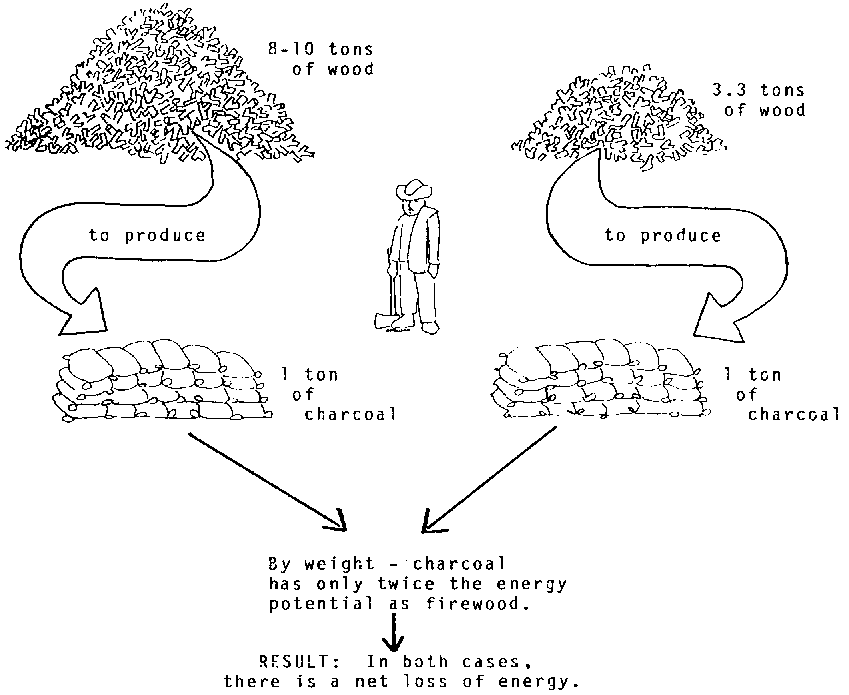
- For Example: Yaoundé, September, 1981
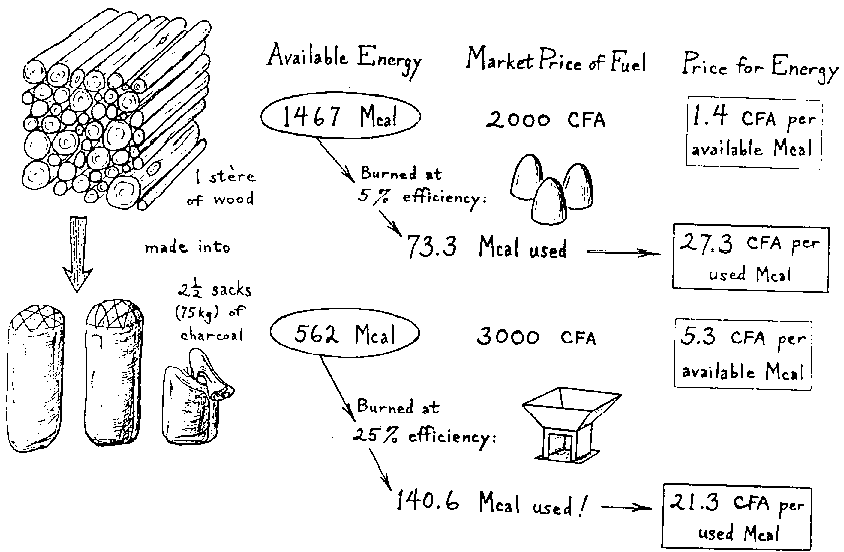
- A reasonable hypothetical example (after D.E. Earl, 1975)
Assume that 1 Gcal (109 calories) of wood energy sells for #1 (one unit currency) at the wood and charcoal production site.
Further, assume that charcoal sells there at #4 per Gcal.
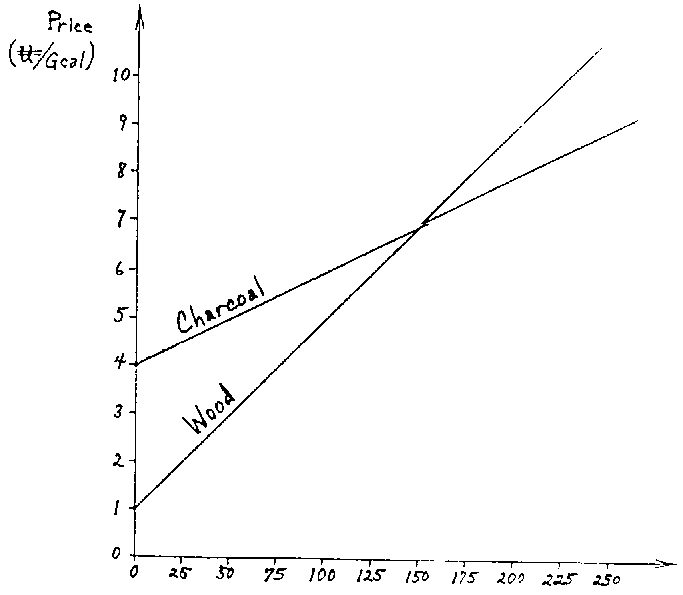
Now, let us say that transportation rates are set at #15 per 100 km. for each metric tonne of the load.
Thus, for charcoal, a tonne of which contains 7.5 Gcal, this works out to #2/Gcal per 100 km.
But, for air-dry wood, which requires about two tonnes to contain the same energy, the transportation rate becomes #4/Gcal per 100 km.
Therefore, at distances greater than 150 km from the production site (in this case), the energy available from burning charcoal is cheaper than that from burning wood.
* CHARCOAL USE IN DEVELOPING COUNTRIES occurs primarily in urban areas where people's energy needs are great and available sources of wood are often great distances away.
* IN CASES WHERE FUEL MUST BE TRANSPORTED more than 50 - SO kilometers, it is more efficient to convert wood into charcoal. The reduced weight and bulk of charcoal make it possible to transport more potential energy at a cheaper price than transporting firewood.
* URBAN AREAS ARE DEMANDING CHARCOAL because it can be made available more cheaply than firewood and is easier to handle in congested urban areas. This demand strains available wood resources in rural areas and increases many of the fuelwood-related problems of rural people.
* THIS CONFLICT OF INTERESTS AND NEEDS between urban and rural peoples has resulted in a variety of governmental attempts to control charcoal production throughout the world. For example:
- the government of Gambia has passed laws which prohibit all types of charcoal production;
- Kenya has established permit requirements which make it almost impossible to legally produce charcoal; and at the same time,
- Senegal has placed price controls on charcoal and consequently encouraged its demand and use.
|
Total Time: |
45 minutes |
|
Objectives: |
* To list past experiences with and/or knowledge of kiln types |
|
* To identify and explain major design features of common kiln types |
|
|
Resources: |
* Attachment 9-A: "Common Kiln Types" |
|
* Attachment 9-B: "Basic Principles of Kiln Design" |
|
|
Materials: |
Newsprint and felt-tip pens |
Procedures:
Step 1. (5 minutes)
Explain the session objectives and briefly review the procedures.
Step 2. (10 minutes) Have the participants form groups of 3-5 and record on newsprint their past experiences and/or knowledge of kiln types.
|
Trainer Notes * Explain that each group should list or sketch kiln types they have seen or heard about. * Have each group post their lists when they have finished. |
Step 3. (10 minutes)
Distribute Attachment 9-A, "Common Kiln Types," and Attachment 9-B, "Basic Principles of Kiln Design, and allow time for participants to review them.
Step 4. (15 minutes)
Ask participants to volunteer to identify and explain the basic design features of each of the kiln types illustrated on Attachment 9-A, "Common Kiln Types."
|
Trainer Notes * Stimulate discussion by asking each volunteer to identify parallels which exist between the kiln types on the Attachment and those listed by the groups in the previous activity. * Record on posted newsprint important design features as they are discussed. * Essential design features and considerations which should be discussed include: - heat transfer - draft systems - sizes of kilns - temperature cycles - kiln volume/capacity - front process - cost of kiln - ease of operation - cultural acceptability - portability - basic design - construction materials - efficiency - labor required |
Step 5. (5 minutes)
Conclude by asking one of the participants to briefly summarize the essential design features of kilns.
|
Trainer Notes * Mention that the considerations discussed in this session can provide the context for the next session on kiln design. * Explain that the term "kiln" is used to refer to charcoal production methods in general, including retorts. |
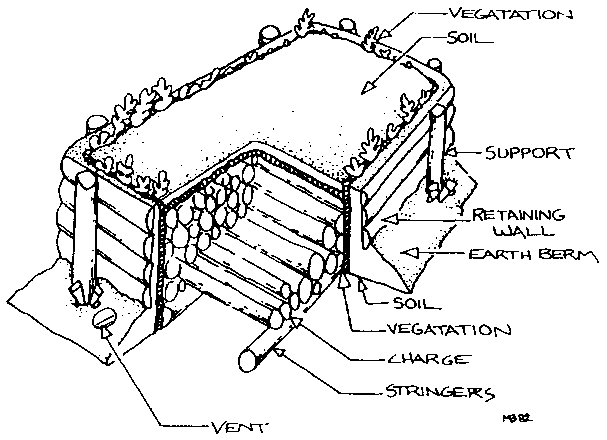
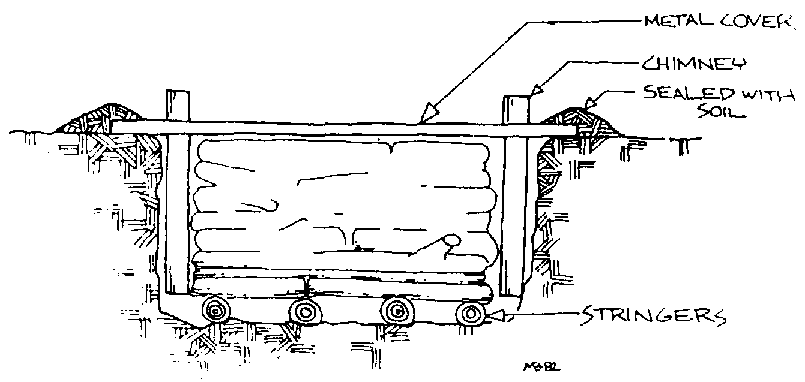
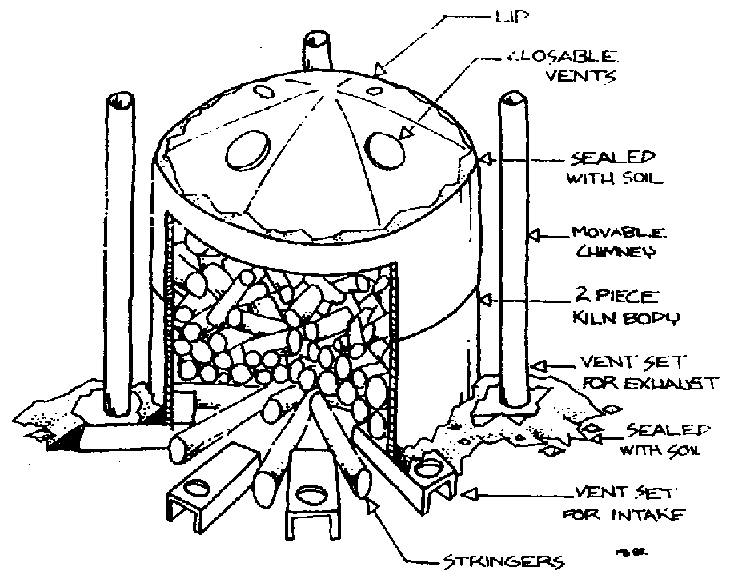
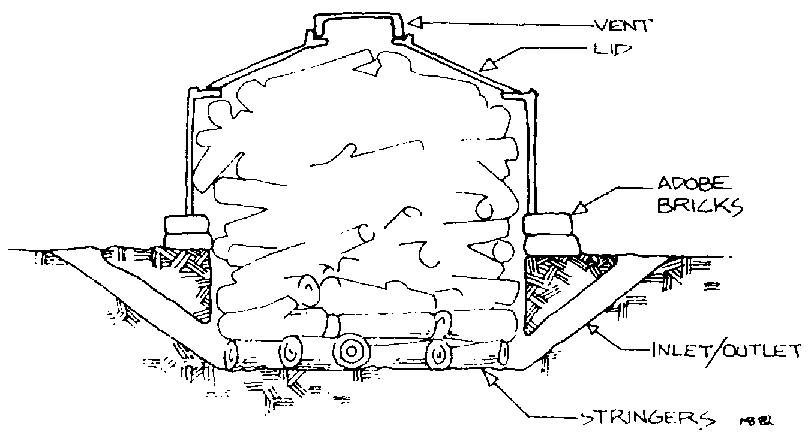
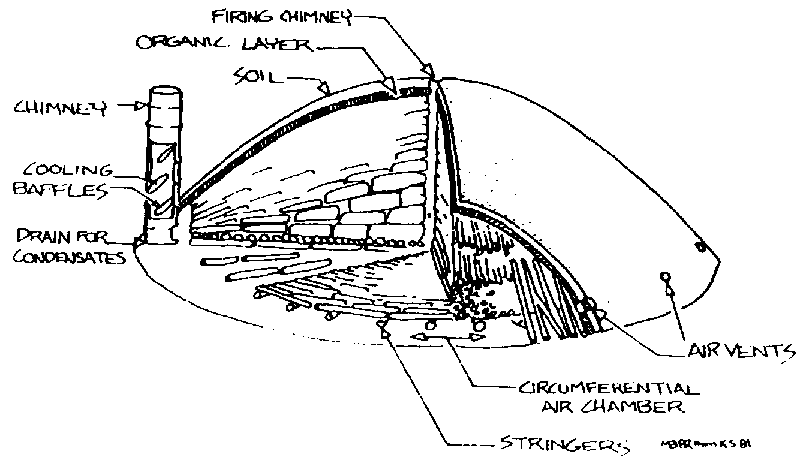
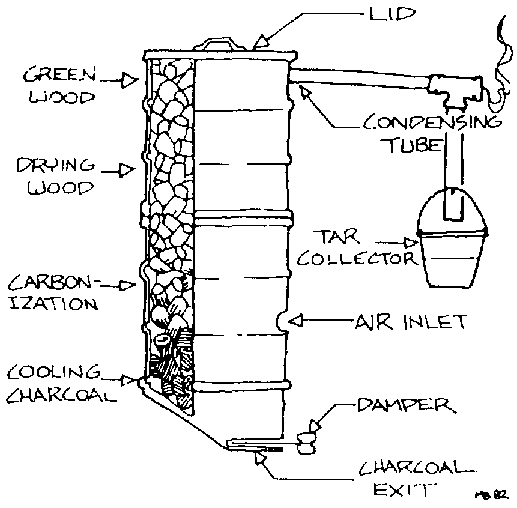
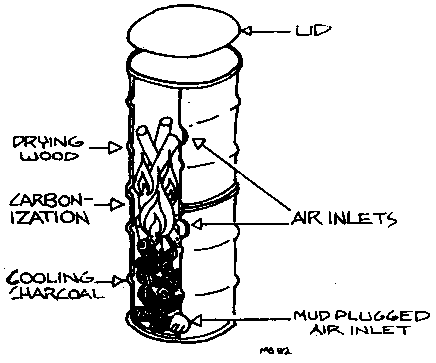
IDEALIZED RECTANGULAR EARTH-COVERED KILNS
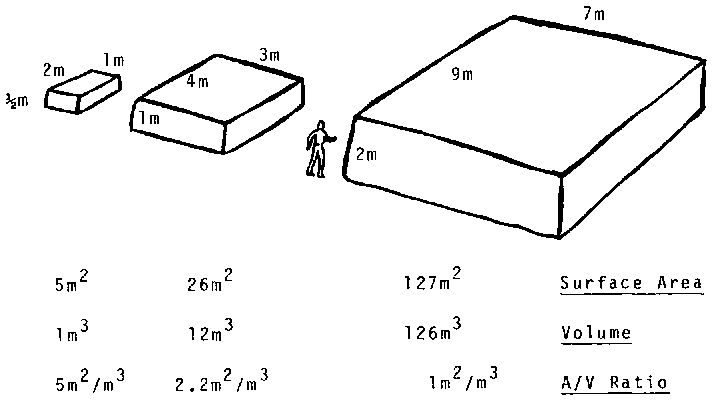
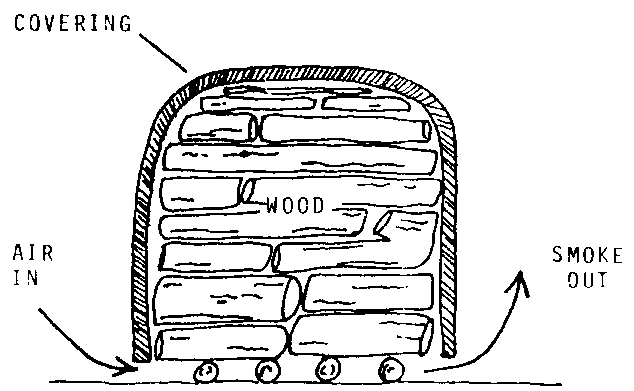
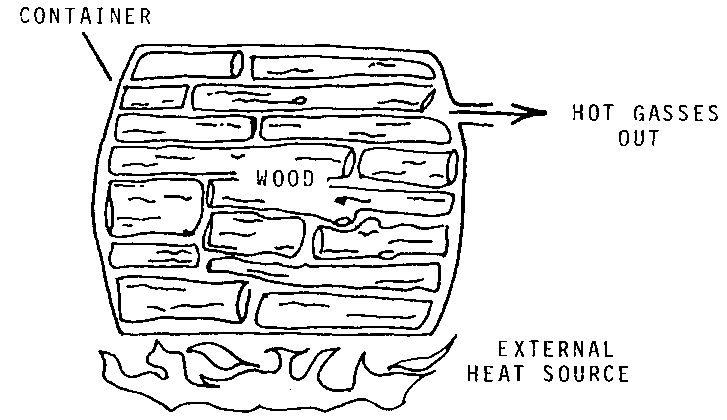
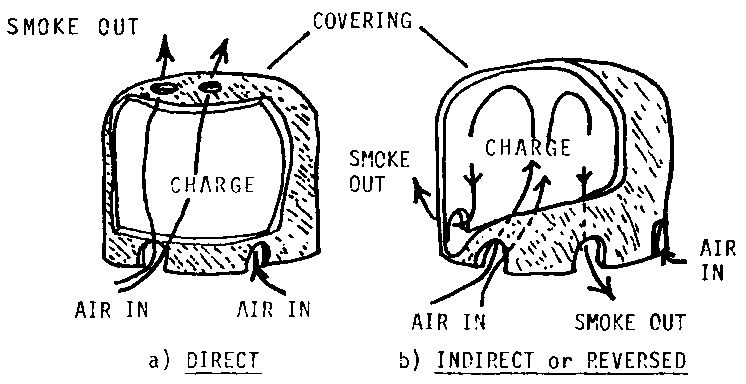
TYPES OF DRAFT SYSTEMS IN A CHARCOAL KILN
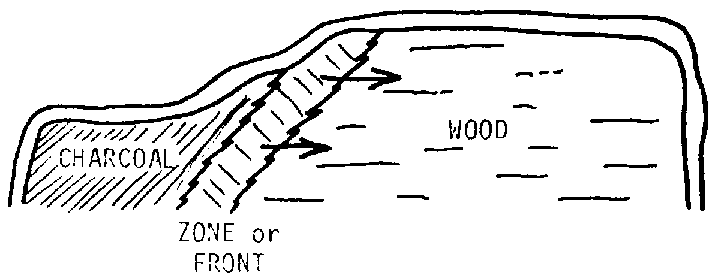
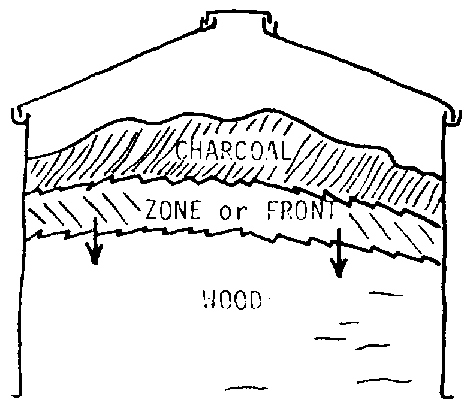
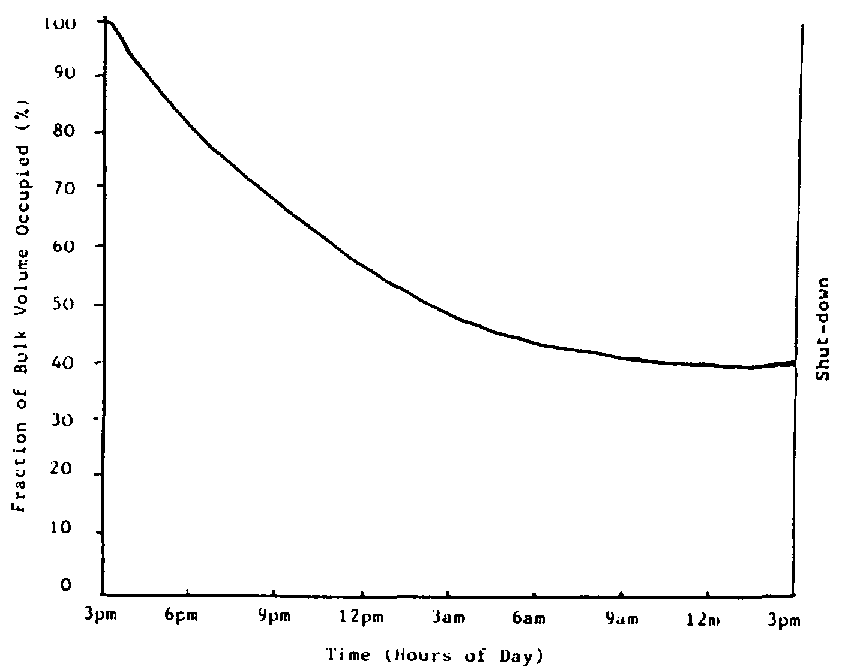
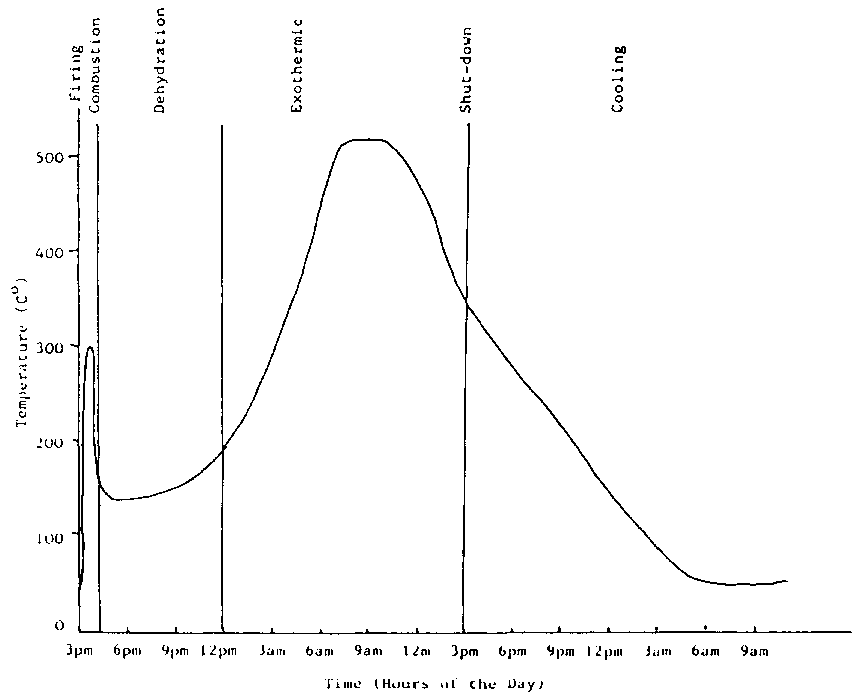
|
Total Time: |
1 hour, 15 minutes |
|
Objectives: |
* To develop a complete kiln design plan |
|
* To present and discuss kiln designs with others in the group |
|
|
Materials: |
Newsprint, felt-tip pens, pencils or pens, paper. |
Procedures:
Step 1. (5 minutes)
Briefly explain the session objectives.
Step 2. (10 minutes)
Outline the procedures for developing kiln designs.
|
Trainer Notes * Explain that participants will divide into groups of three or four and develop, in writing, a kiln design plan which includes the following components: - a list of design criteria - a list of necessary materials - a list of necessary tools - an estimated cost - a sketch or drawing of the design * Stress the importance of beginning the design process by identifying design criteria. * Suggest that one way to develop a design is to have each member of the work group sketch as many kiln designs as possible on notebook paper, then choose one sketch which best meets the group's criteria. * Remind participants that they will have only two hours to construct and fire their kilns, so the designs should not be too complex or difficult to construct. Also, mention that on Day 3, there will be ample opportunity to modify and re-design the kilns based on the experience of this first run. * Point out that each group will present and explain its design when they are finished. |
Step 3. (25 minutes)
Have the participants form their work groups and develop their kiln design plans.
|
Trainer Notes * Circulate among the groups and offer assistance and suggestions. Be careful not to force your ideas on them. Offer support and encouragement in the form of suggestions. |
Step 4. (30 minutes)
Reconvene the groups and have them present their design plans.
|
Trainer Notes * As each group is presenting its design, ask other participants to provide suggestions for improving feasibility, completeness and/or simplicity. |
Step 5. (5 minutes)
Briefly review the session and explain that in the next session, participants will construct, load, and fire the kilns they have designed.
|
Total Time: |
2 hours |
|
Objectives: |
* To construct miniature kilns based on design plans |
|
* To load, fire, and seal miniature kilns |
|
|
* To discuss problem-solving techniques used by work groups during the design and construction activities. |
|
|
Resources: |
A sample kiln (for demonstration purposes). |
|
Materials: |
Machetes, saws and pruning shears (if available), wood for making charcoal (see Session 5), hoes, shovels, large forks and spoons, assorted sizes and lengths of metal pipe, tin cans, 20 liter buckets, assorted metal working tools, wire, sheet metal, 20 liter cans, 1 square meter of clay, 1 square meter of sand, several large buckets of water, a supply of succulent, green organic matter. |
|
Trainer Notes * This list includes those materials considered essential in carrying out the activities involved in constructing, loading, firing, monitoring and extracting the kilns. |
|
Trainer Notes * This session will require preparation. It will be necessary to construct a sample, miniature kiln to serve as a basis for demonstrating, loading, and firing. (See Steps 3 and 6). It is recommended that this sample kiln be a CASAMANCE type, since it represents a basic variation of the traditional kiln and employs all the basic design features of a charcoal kiln. * The kiln site should be made ready by having all the necessary construction equipment available, and by making sure the appropriate fire precaution measures have been taken. * To save time later in the evening, it is suggested that the materials and resources for the nightwatch activity (see Session 12) be brought to the kiln site as well. |
Step 1. (5 minutes)
Briefly explain the objectives of the session and outline the procedures.
Step 2. (30 minutes)
Have the participants form their work groups and construct miniature kilns based on the design plans developed in the previous session.
|
Trainer Notes * Explain that "construction" involves gathering the necessary materials and setting up the kiln site to the point of being ready to fire the kilns. * Keep in touch with how the groups are proceeding, taking time to offer suggestions, demonstrate the proper use of tools, etc. * Ask each group to advise you when they are ready to load their kilos. |
Step 3. (15 minutes)
When the work groups have completed construction of their kilns, demonstrate proper loading and covering techniques on the sample kiln.
|
Trainer Notes. * As you are loading the sample kiln, it is important to demonstrate and explain the following techniques: - wood placement - filling and packing to minimize internal air drafts - construction of firing point - covering with earth and vegetation * Stimulate discussion by asking participants to explain the relation of each technique to heat transfer and draft principles. * Ask that two or three of the participants volunteer to help you complete the loading and covering of the sample kiln. |
Step 4. (20 minutes)
Have the work groups return to their kiln sites and complete the loading and covering of their kilns.
|
Trainer Notes Circulate among the work groups and offer suggestions and guidance when necessary. |
Step 5. (15 minutes)
Ask the work groups to gather around the sample kiln and observe as you demonstrate proper firing techniques.
|
Trainer Notes * Take a few minutes at this time to review the basic fire precaution procedures explained in Session 4, "Introduction to Carbonization." * In demonstrating firing techniques, be sure to stress the following: - the use for coals from an external fire - packing coals into firing chamber - high smoke volume as signal to seal kilns * Stimulate discussion by asking participants to explain the relation of each technique to such principles as heat transfer draft, and fire safety. |
Step 6. (15 minutes)
Have the work groups return to their kiln sites and fire their kilns.
|
Trainer Notes * As one group completes the firing of their kiln, have them provide assistance to any other groups that may be experiencing difficulties. |
Step 7. (15 minutes)
When all the kilns are fired and burning, reconvene the group and discuss the problem-solving techniques used by each work group during the design and construction processes.
|
Trainer Notes * Ask participants to give examples of some of the difficulties they have experienced as development workers in working with groups and communicating new technical concepts to host country individuals. Ask them to compare these examples to experiences they had working with their work group during the design and construction activities. * Stimulate discussion by asking the following questions: - Was there a particular pattern to the problem-solving techniques used by your group? - What was the most challenging phase of the afternoon's activities for your group? - Do you think there would be similar problems in working with host country individuals? If not, how would they be different? - What could be done to improve your working styles with one, another? With host country individuals? |
Step 8. (5 minutes)
Conclude the session by reminding participants that the kiln activities will be continuing into the night.
|
Trainer Notes * Explain that burning kilns must be continually monitored and that night vigils are a common aspect of the life of a charcoal maker. |
|
Total Time: |
8 hours (approximately) |
|
Objectives: |
* To identify signs which indicate that kilns are functioning properly |
|
* To identify signs which indicate that kilns are functioning poorly |
|
|
* To repair malfunctioning kilns |
|
|
* To discuss the potential health and safety hazards associated with kilns |
|
|
* To extract a kiln |
|
|
* To identify grades of charcoal |
|
|
Materials: |
(see "Materials" for "Kiln Construction", Session 11) as desired--tents, sleeping bags, mosquito repellent, candles, lanterns, flashlights, ingredients and utensils for preparing a meal, coffee, tea, music. |
|
Trainer Notes * The nightwatch activity will continue until the kilns have been extracted. It is estimated that firing the kilns at 6 PM will allow them to be ready for extraction at approximately 1 or 2 AM. * An appropriate informal atmosphere should be established for this activity. It is recommended: - that participants set up protection from the elements (i.e., tents, sleeping bags, mosquito repellent) - that there is an ample supply of light sources (i.e., flashlights, lanterns, candles, etc.) - that a dinner be prepared on an open fire or using charcoal cookers - that there be coffee or tea, and music available for the later hours when enthusiasm and energy may be waning. * This session is designed to allow for considerable latitude in timing and execution, depending on individual trainer styles and the needs of the participants. It is recommended that the trainer remain sensitive to the group's need for both rest and stimulation. For example: - Part 1, "Monitoring and Trouble-Shooting" should occur in an ongoing fashion as problems or indications arise. - Part 2, "Health and Safety Factors" can occur at a time when the group seems to need some stimulation (perhaps late in the night). - Part 3, "Kiln Extraction" will need to occur as a final activity whenever the kilns are ready to be disassembled. |
PART 1: MONITORING AND TROUBLE-SHOOTING
|
Total Time: |
Continuous throughout the 8-hour period. |
Procedures:
Step 1.
Circulate among the kiln sites and discuss examples of kilns which appear to be functioning well.
|
Trainer Notes * Invite participants to gather around the kiln and explain why it seems to be functioning well. * Stimulate discussion and dialogue by asking: - How do we know that this kiln is functioning well? - What indications are present? - What is happening inside the kiln? * For each kiln, it is important to discuss: - movement of the front - the draft system - color, smell, and volume of smoke |
Step 2.
Circulate among the kiln sites and discuss examples of kilns which appear to be functioning poorly.
|
Trainer Notes * Invite participants to gather around the kiln and explain why it seems to be functioning poorly. * Stimulate discussion and participation by asking: - How do we know this kiln is functioning poorly? - What indications are present? - What can be done to repair it? * Some common malfunctions which should be discussed include: - poor draft - holes - fires dying out - irregular front progression * It is important that each work group take the necessary steps to repair their kilns. Offer suggestions whenever necessary, but try to rely heavily on the group's problem-solving abilities. |
PART 2: HEALTH AND SAFETY FACTORS
|
Total Time: |
1 hour (approximately) |
Procedures:
Step 1. (45 minutes)
Guide the participants on a tour of each kiln and discuss the potential health and safety dangers of each design.
|
Trainer Notes * Mention that, to some degree, all kilns are potentially dangerous, both to those who build them and to by-standers. * Stimulate discussion by asking the following questions: - What are some of the most dangerous aspects of this design? - Who might be most affected by these dangers? (i.e., animals, by-standers, the charcoal makers, etc.) - What could be done to diminish the potential health and safety hazards represented by this kiln? * Some common health and safety factors to be discussed include: - smoke inhalation - open vents - burns from hot metal - sides caving in |
Step 2. (15 minutes)
Conclude the tour by asking the participants to summarize the major health hazards associated with kilns.
PART 3: CHARCOAL EXTRACTION
|
Total Time: |
2 hours (approximately) |
Procedures:
Step 1 (15 minutes)
When the first kiln appears ready to pull, invite the participants to gather around it and discuss signs which indicate that the kilns should be disassembled.
|
Trainer Notes * Stimulate discussion and participation by asking: - How do we know this kiln is ready to pull? - What indications are present? * Some common indications which should be discussed include: - completion of front progression - cooling of the kiln - absence or reduction of smoke - coals visible through vents |
Step 2. (10 minutes)
Briefly explain the basic procedures for charcoal extraction and answer questions from the group.
|
Trainer Notes * Include the following points in your explanation: - clear an area around the kiln that is large enough to spread the charcoal without stacking it. - Open the kiln, one small section at a time, and extract the charcoal by pulling it into the cleared area. - Watch for burning coals and extinguish them with loose soil. (Be careful not to bury the charcoal.) - Keep the pulling and dragging of the charcoal to a minimum since it fragments easily when hot. - Stack charcoal in concentric windrows after it has cooled. - Leave paths between each windrow to prevent walking on the charcoal and to act as firebreaks. - The design of some metal kilns requires that all the charcoal be removed at once. In these cases it may be necessary to open the kilns and cool them with a spray of water before disassembling. This should be done only in special circumstances since wetting the charcoal reduces its quality. |
Step 3. (20 minutes)
Ask the work group to pull their kilns while the other participants observe the process.
|
Trainer Notes * Offer suggestions and advice whenever necessary. * Remind the group that they are working with miniatures and that the larger scale of full-sized kilos would necessitate a strict adherence to the basic extraction procedures. |
Step 4. (15 minutes)
As each layer is being extracted from the kiln, identify and discuss the various grades of charcoal found in the kiln.
|
Trainer Notes * Stimulate discussion by asking: - Approximately what percent of the wood is completely carbonized? - What happened to cause some of the wood to only partially carbonize? * Some important points which should be brought out in this discussion include: - the importance of re-covering earth kilns - the causes of ash spots - the causes of brands |
Step 5. (60 minutes)
Ask the participants to return to their work groups and pull their kilns when the carbonization is complete.
|
Trainer Notes * Each of the kilns will be ready to be disassembled at different times. If the work groups seem to be getting extremely tired, it is recommended that they go ahead and extract the charcoal, even though all the wood inside may not be completely carbonized. * Explain that on the next afternoon, there will be a review of the entire kiln construction activity and that ample time will be provided for participants to examine their charcoal and ask questions. * Before dispersing for the night, make sure that charcoal is stacked appropriately for cooling and that there is no danger of fire from any of the disassembled kilns. |
|
Total Time: |
1½ hours |
|
Objectives: |
* To review the kiln construction activities from the previous day |
|
* To develop a modified kiln design |
|
|
* To evaluate the effectiveness of problem-solving techniques used by work groups. |
|
|
Materials: |
Newsprint, felt-tip pens, pencils or pens, notebook paper. |
|
Trainer Notes * This session requires some preparation. Write on newsprint the "Outline of the Design Process" in Step 2, and the "Outline of the Re-design Process" in Step 4. |
Procedures:
Step 1. (5 minutes)
Explain the objectives of the session and briefly outline the procedures.
|
Trainer Notes * Explain that the purpose of the first objective is to allow participants the opportunity to clarify, summarize and assess the kiln design and construction activities from the previous night. |
Step 2. (5 minutes)
Post and explain a basic overview of the design process.
* Explain that this list represents a general step-by-step outline of the design process that can be applied to any technical device.
Step 3. (10 minutes)
Ask participants to give an example for each step in the design process from their experience designing their kilos.
|
Trainer Notes * Ask participants to identify the examples, record them on the posted newsprint beside each corresponding step in the design process outline. |
Step 4. (10 minutes)
Post and explain a basic overview of the re-design process.
|
Trainer Notes * Post the following list on newsprint: Evaluate Results (based on criteria) Modify Criteria (if necessary) Re-Design Re-Construct Re-Test * Point out that no design is complete until it has been tested and re-tested and that every new design requires re-design and re-construction. * Explain that the remainder of this day and all of tomorrow will be devoted to carrying out the steps involved in the re-design process. |
Step 5. (40 minutes)
Have the participants form their original work groups and develop a modified design of their kilns.
|
Trainer Notes * Explain that each work group should evaluate the results of their kiln in view of their original criteria and any additional factors of which they are now aware. * Ask that each group prepare a modified criteria list and a new design drawing. * Suggest that new designs include such considerations as: - improved health and safety precautions - more attention to factors blocking/enhancing cultural acceptability - improvements in ease of construction - increased efficiency - more effective firing systems - emphasis on use of specific wood types to produce desired density of charcoal - improvements in draft system to ensure more even heating and front movement - specific applicability to their work sites - more ease of unloading and cooling charcoal - availability of construction materials * Circulate among the groups and provide any necessary suggestions for improving feasibility, completeness, and simplicity of the new designs. |
Step 6. (10 minutes)
Reconvene the work groups and ask participants if there are any final technical points to be clarified before moving into the construction and testing of the new kiln designs.
|
Trainer Notes * Any specific technical issues or facts which were not adequately reviewed and stressed as a result of the re-design work should be clarified at this point. |
Step 7. (10 minutes)
Conclude by asking participants to briefly evaluate the effectiveness of the problem-solving techniques used by their work groups to this point.
|
Trainer Notes. * Stimulate discussion and dialogue among the participants by asking the following questions: - Do you feel that your group's ability to work together to solve problems has improved? How? - What recommendations would you make to improve the effectiveness of your work group? |
|
Total Time: |
12½ hours (approximately) |
|
Objectives: |
* To construct a modified, second kiln |
|
* To test a modified, second kiln |
|
|
* To practice working independently |
|
|
Materials: |
(See Materials listed for Session 11, "Kiln Construction") |
|
Trainer Notes * Preparation required for this session involves: - setting up the materials necessary for constructing, loading, firing, covering, monitoring, and extracting a second set of miniature kilns; and - preparing on newsprint an outline of the schedule for Days 3 and 4 (see Step 2). |
Procedures:
Step 1. (10 minutes)
Explain the session objectives and briefly review the procedures.
|
Trainer Notes * Explain that the time for constructing. loading, covering, firing, monitoring, and extracting the second kiln will vary according to the relative efficiency of the designs developed during the previous session. * Stress that constructing a second, improved kiln is an opportunity for independent work, creative problem-solving, and the application of charcoal making principles learned to date. * Clarify that the trainer's role during this period will be to keep in touch with the work groups, demonstrate the use of tools and equipment, make suggestions, and answer questions as needed. |
Step 2. (20 minutes)
Post, explain and finalize the schedule for Days 3 and 4.
|
Trainer Notes * Post the following schedule outline on newsprint |
|||
|
Day 3 |
Monitoring trouble-shooting |
Day 4 |
|
|
AM |
Firing |
||
|
Introduction to Presentations (½ hour) |
|||
|
PM |
Construction |
Kiln Application & Innovation (1 hour) |
|
|
Loading |
Extracting (cooling) |
||
|
* It is important to point out that the work groups should effectively prioritize their time so their kilns will be covered and ready to fire in the time remaining on Day 3. * If one or more of the groups has not completed its kiln up to the point of firing by the end of Day 3, explain that they may choose to either continue working or leave the work until the following day. The key factor in deciding which option to choose is that the kilns should be fired by no later than 8:30 AM on Day 4 to allow for sufficient burn time before extraction. * Explain that the majority of Day 4 will be for independent work in firing, monitoring, and extracting the second kilns. * Ask the participants to determine the specific times that they would like for Session 15, "Introduction to Presentations" and Session 16, "Kiln Application and Innovation" to occur. Explain that approximately ½ hour will be needed for Session 15, and that approximately 1¼ hours will be needed for Session 16. Recommend that Session 15 occur early in the day so as to allow ample opportunity to think about and plan the presentations on Day 5. |
|||
Step 3. (12 hours)
Have the participants form their work groups and begin working.
|
Trainer Notes * Remind participants that they will be working independently for the remainder of Days 3 and 4. * Throughout the construction and testing period, occasionally remind participants of how many hours remain and what tasks are left to be accomplished. Encourage participants to focus on essential tasks and to divide them among group members to help speed up the process. * Fire precautions are an essential aspect of any kiln operation. Keep in touch with each work group and point out, whenever necessary, any potential fire hazards. |
|
Total Time: |
30 minutes |
|
Objectives: |
* To discuss the objectives and format of tomorrow's session, "Presentation of Kilns." |
|
* To identify what information should be included in the presentations. |
|
|
Materials: |
Newsprint and felt-tip pens. |
|
Trainer Notes This introduction should occur early in the morning on Day 4 to allow the participant sample preparation time for their presentations scheduled for Day 5. |
Procedures:
Step 1. (10 minutes)
Present the session's objectives and give an overview of tomorrow's session, "Presentation of Kilns."
* The participants may be given the option of asking the rest of the group to role-play, during their presentation, a particular audience-type (e.g., traditional charcoal-makers, in-country counterparts, or forestry extensionists). By allowing the participants freedom in defining their audience, you increase the potential for variety and creativity in the presentations. If any role-plays are done, be sure the roles and situations are explained beforehand.
Step 2. (15 minutes)
Ask the group to develop a list of essential information to be included in each presentation.
|
Trainer Notes If their list appears too lengthy and ambitious for short presentations, suggest where it may be pared down. |
Step 3. (5 minutes)
Ask the group if any further clarifications are needed. Conclude by stressing the value of using a variety of communication techniques and creating a climate of group participation during the presentations.
|
Total Time: |
1 hour, 15 minutes |
|
Objectives: |
* To apply experience in kiln design and fuelwood use in a variety of situations |
|
* To discuss socio-economic factors which affect the feasibility and acceptability of kiln types |
|
|
Resources: |
* Attachment 15-A, "Design Situations" |
|
* Attachment 16-B, "Realities of Making Charcoal" |
|
|
Materials: |
As determined by participants. |
|
Trainer Notes * This session is designed to give participants an opportunity to adapt and apply their knowledge and experience in charcoal production to actual situations. These situations may be modified to make them more country- or project-specific. * The entire activity can be done at the work site to accomodate on-going kiln surveillance. |
Procedures:
Step 1. (5 minutes)
Explain the objectives and procedures.
Step 2. (10 minutes)
Ask the participants to form 4 groups and give each group one of the situations from Attachment 16-A, "Design Situations." Explain the task as described in the Trainer Notes.
|
Trainer Notes * Based on the information given in the situations and the participants' experience, each group should choose and/or design one or more kilns which would be best suited for use in that situation. * In addition to kiln selection, each group should assess fuelwood practices and the overall process of charcoal production as described in the situation and decide how other improvements, if any, could be made. * Each group will present their kiln designs and recommendations to the large group. |
Step 3. (15 minutes)
Have the design groups work through the situations.
|
Trainer Notes The situations are purposefully sketchy to allow for maximum creativity from participants. |
Step 4. (25 minutes)
Reconvene the groups and ask each one to describe the case and present their recommendations.
|
Trainer Notes After each presentation, allow a few minutes for questions and comments from the group. If necessary call the group's attention to any particularly appropriate designs which have been overlooked. |
Step 5. (10 minutes)
Facilitate a short discussion of the socioeconomic factors which need to be considered in charcoal-making situations.
|
Trainer Notes Ask the participants to give examples of any successes or failures in charcoal-making they have heard of or seen in their communities or regions. |
Step 6. (10 minutes)
Distribute copies of Attachment 16-B, "Realities of Making Charcoal" and ask the group to review it.
|
Trainer Notes Explain that the information provided in this Attachment is meant to serve as reference material and that it should be read thoroughly prior to Session 19, "Evaluating Charcoal Yields" on Day 6. |
Situation 1
* Small sawmill on the outskirts of a medium-sized town.
* Mill-ends, slab and sawdust and stockpiled first and later burned. Some of the lumber is occasionally purchased by employees.
* Some capital is available for general improvements and repairs.
* Mill labor force includes skilled and unskilled workers.
* Variety of "junk" items on the premises.
* Mill tool shop has welding equipment.
Situation 2
* Fuel wood plantation in a sparsely-populated area.
* Cleared land is planted on a 10-year rotation. Some tracts are ready for harvest.
* Additional natural forest is being cleared with large equipment (Caterpillars, etc.). To facilitate immediate planting, large amounts of ungraded material from the clearing process are quickly wind-rowed and burned.
* Some capital is available for improvements and repairs.
* Heavy equipment available (e.g., Caterpillars, graders, front-end loaders, trucks, chainsaws, etc.).
Situation 3
* Independent charcoal-maker who works in the area around his village.
* Money earned from charcoal accounts for 95% of his family income.
* Markets his product in a large town 150 km. away.
* Transportation costs drastically reduce his profit.
* Tools are old and few.
Situation 4
* Traditional farmer in a populated, rural area.
* From clearing his bush fallow to plant, he has a sudden and large surplus of wood.
* Almost all his labor time is spent tending his farm.
* Owns a few, basic agricultural tools.
by H. E. Booth
H. E. Booth is an authority on charcoal production. This article was edited from an FAO paper he prepared for the United Nations Conference on New and Renewable Sources of Energy, Nairobi, August, 1981, and reprinted from UNASYLVA, Vol. 33, No. 13, Food and Agriculture Organization of the United Nations, Rome, Italy.
The portable steel charcoal kiln consists of two cylindrical steel shells, a conical lid and four chimneys. It has been tried extensively in charcoal production throughout the world for many years.
Under suitable conditions, this kiln will make good charcoal. There are a number of examples in the developed world where it has been used successfully for many years producing charcoal on a fairly small scale. In the developing world, however, where these kilns have been tried, it is usually found that after a period of time, there is a reversion to traditional methods such as the earth pit.
Meanwhile, the various kinds of brick kilns have continued to produce more and more charcoal in the developing world. This may seem surprising when it is considered that the steel kiln appeared in Europe in its present form more than 50 years ago. The reason for its failure in the developing world is that is requires certain specific conditions which either are not present or can be provided only in uneconomic ways. In Europe, on the other hand, these conditions are available, and thus the steel kiln continues to play a useful part in charcoal production. Briefly, these conditions are:
- A high-price charcoal market.
- Ready availability of cheap steel and corresponding fabrication and repair facilities.
- Ready availability of transport facilities, i.e., roads and vehicles and the means to process and carry small quantities of timber and charcoal in scattered locations using a mobile, highly skilled work force.
- No shortage of investment and operating capital.
The typical situation in a developing country is rather different. There, the traditional method of making charcoal is to carbonize the wood in pits dug in the ground or on the side of a hill, or to cover a pile of firewood with mud and earth--the so-called earth-clamp, or "parva". In most cases, charcoal making is carried out by people without any access to investment capital. Such capital is indispensable; although it can, if necessary, be on a low level, involving people whose technological experience is limited.
A higher level of technology is available from portable steel kilns or from kilns made of bricks and set in mud mortar. While brick kilns are not mobile, they can readily be dismantled and rebuilt. In either case, there has to be a transfer of technology. The imported steel kiln has the advantage of making a whole kiln available instantly, but it requires back-up maintenance such as steel-plate welding and heavy sheet-metal working capability. These are usually quite beyond the local charcoal makers and have to be provided on a state or cooperative level, usually as a loss operation.
Brick kilns must therefore be built. Building them is a comparatively new technique requiring a supply of bricks or the ability to make simple direct-fired bricks from a sandy clay. Given these prerequisites, maintenance of brick kilns is very simple. They are virtually immune to damage from local overheating, unlike steel kilns. The only maintenance normally needed is the pouring on of mud slurry to seal cracks. Furthermore, when the kilns must be moved, say a few kilometers away, they are simply dismantled and the bricks re-assembled at the new site. However, brick kilns should be used only in cases where frequent relocations are not to be expected and where wood can be transported to the kiln.
Some type of brick kilns have no steel at all, merely mud and bricks. Others, such as the Brazilian type, have a ring of fencing wires to provide tensile reinforcement at the base of the cupola roof. The brick kiln is much larger than the steel one and hence, produces ten to twenty times more charcoal at a single burn. The brick kiln has doors, a fact that makes loading and unloading simple, since wheelbarrows, carts and sometimes conveyor rolls can be used.
The steel kiln requires the wood the charcoal to be loaded and unloaded over the top rim of the bottom section of the unit, a laborious and dusty undertaking. The wood first has to be reduced to block form, typically not bigger than 30 x 10 x 10 cm. Hence, chainsaws and complex block-splitting machines are needed to make wood preparation practical. By contrast, both earth pits and clamps and brick kilns can utilize large logs of up to 50 cm. diameter and 1 to 2 meters in length. Typically, the wood is simply cut into billets about 1.8 meters lone.
Two problems affect the steel kiln in particular. First, since air leaks occur easily at the ground line, hot spots can crop up during a burn, leading to buckling and collapse of sections of the shell. This problem is reduced, but not eliminated, where the kiln is made of more costly heat-resisting steel. Hot spots also occur with brick kilns, but they do not damage the kiln itself. The second special problem of steel kilns arises from its low insulation value. The action of rain and wind can cause the kiln walls to become too cold. This slows down the exothermic decomposition of the wood near them and results in an excessive production of party carbonized wood known as "brands." Brick kilns, because of their greater size and better insulation, are less susceptible.
Finally, it should always be borne in mind that the burning stage is only one small, though essential, step in charcoal production. The more important steps are the harvesting and transport of the fuelwood, and the delivery and distribution to market of the finished charcoal. The imported steel kiln gives an illusion of instant charcoal availability which tends to blur the vision of administrators and officials taking a good hard look at the real problems affecting charcoal supply in a developing country.
ADVANTAGES AND DISADVANTAGES OF STEEL KILNS COMPARED TO OTHER TYPES
|
FACTOR |
PORTABLE STEEL KILN |
EARTH PIT |
BRICK KILN |
|
Cost in place ready to run (US$) |
5,000 |
- - |
1,000-2,500 |
|
Internal volume (m3) |
6.5 |
8-30 |
50-130 |
|
Cycle time (days) |
3-4 |
20-30 |
9-25 |
|
Maintenance |
skilled with workshop |
simple |
simple |
|
Mobility |
yes |
yes |
demolish and rebuild |
|
Life (years) |
1.5-4 |
- - |
8-10 |
|
Charcoal quality |
good |
fair |
good |
|
Typical yield (percent weight basis) |
20 |
15 |
20 |
|
Ease of burning |
simple |
difficult simple |
|
|
Maximum size of fuelwood (cm.) |
30 x 5 x 5 |
no limit |
200 x 30 x 30 |
|
Performance in rainy climate |
good |
poor |
good |
|
Ability to tolerate "hot spot" and accidents |
poor |
fair |
good |
|
Total time: |
2 hours |
|
Objectives: |
* To present the completed kilos and results of the kiln runs * To practice communicating technical concepts and information effectively |
|
Materials: |
As determined by the work groups |
Procedure:
Step 1. (5 minutes)
Review the objectives and format.
|
Trainer Notes * Remind the groups of the time limit and ask one of the participants to serve as timekeeper to prevent "run-overs." |
Step 2. (1 hour, 45 minutes)
Have the groups give their presentations.
|
Trainer Notes * At the end of each presentation, allow a few minutes for feedback on the effectiveness of each. Ask the group to comment on: - clarity - sequence and variety - techniques which promoted/inhibited group participation and learning - ways to improve |
Step 3. (10 minutes) After the final presentation, briefly discuss with the group any problems they have encountered in conveying technical concepts and ideas in a cross-cultural context.
|
Total Time: |
4 hours |
|
Objectives: |
* To identify the advantages and disadvantages of briquetting |
|
* To discuss the feasibility of small-scale briquetting |
|
|
* To make briquettes |
|
|
* To practice group problem-solving |
|
|
Resources; |
* Attachment 18-A, "Simple Techniques for Bio-Fuels" |
|
* Attachment 18-B, "Briquetting as a Cottage Industry: A Case Study" |
|
|
* Attachment 18-C, "Bamako Briquettes" |
|
|
* Attachment 18-D, "Binders for Charcoal Briquettes" |
|
|
Materials: |
Charcoal from the training kilns; mortar and pestle, two rocks, commercial grinder, etc., for powdering charcoal; binders (see Attachment 18-D "Binders for Charcoal Briquettes"); fire, water, pots, and containers for cooking and mixing; materials for construction of briquetting presses (see Attachments "Bamako Briquettes" and "Simple Techniques for Basic Bio-Fuels"); tools for construction of the presses. |
|
Trainer Notes Listed above are a number of possible materials for making, briquettes. To encourage resourcefulness and creativity, only items which can be obtained locally should be provided for the activity. |
Procedures:
Step 1. (5 minutes)
Explain the objectives and briefly outline the procedures.
Step 2. (15 minutes)
Distribute and have the participants read the Attachment 18-A, "Simple Techniques for Bio-Fuels"
Step 3. (15 minutes)
Ask the group to brainstorm a list of the possible advantages and disadvantages of charcoal briquettes based on the information in the article and their experience. Record their responses on newsprint.
|
Trainer Notes Some advantages and disadvantages include: Advantages - can be made from agricultural "wastes", e.g., powdery dust from kilns, small brush, coffee husks, peanut shells - can be made from soft woods unsuitable for regular charcoal - 30-40% extended burning time from increased density - slower, steadier heat release from increased density - easier to calculate amount of heat in a given number of briquettes - more energy per weight and bulk in transport - easy to sell in small, standard lots - custom design by mixing types of wood and additives Disadvantages - more expensive - manufacture requires more time, steps, and equipment - greater potential for increased costs and/or price-fixing by distributors - requires "big business" skills and techniques in production and marketing, e.g., stockpiling, distributing, etc. - usually dependent on specialized market - high potential as export product; technology could be abused, resulting in greater fuelwood shortages - briquettes are a new and unfamiliar fuel form to many people - certain binders may be culturally rejected - binder may a food source - depending on the binder, briquette may need curing or baking |
Step 4. (10 minutes)
Distribute Attachment 18-B, "Briquetting as a Cottage Industry: A Case Study", and discuss the feasibility of village-level briquette manufacture.
Step 5. (10 minutes)
Distribute Attachment 18-C, "Bamako Briquettes" and Attachment 18-D, "Binders for Charcoal Briquettes" and outline the briquette-making activity.
|
Trainer Notes Explain the following: * The participants will form small work groups and make briquettes. * The activity is one of problem-solving. Each group will have to design a method for crushing the charcoal, to select and prepare a binder, construct a press, and combine all the parts to make a finished product. * The work groups will need to organize themselves efficiently to perform all of the tasks in the required time. * The two resource attachments describe the procedures involved in briquette-making. |
Step 6. (2 hours, 35 minutes)
Have the work groups make briquettes.
Move from group to group, providing input as requested, but avoid directing the problem-solving task.
Step 7. (30 minutes)
Reconvene the participants, and ask each group to demonstrate their briquetting method and discuss its workability.
|
Trainer Notes Stimulate discussion by asking the groups to describe: - how they approached the task. - what problems were encountered with the grinder, binder, press, etc. - how the problems were solved - any suggestions for improving the method - potential application of the method at their sites |
by Jacek Janczak
Jacek Janczak is a Polish engineer. He wrote this article originally as an FAO study for the United Nations Conference on New and Renewable Sources of Energy, Nairobi, August 1981.
Simple fuel technologies for developing countries are based on available resources and the "do it yourself" principle. While the tools for processing fuel may be manufactured locally, what is needed is a well-organized demonstration and training program covering large areas of these countries.
Although simple processing increases the heat value of big-residues considerably, every kind of fuel calls for a specific type of stove or furnace to provide optimal combustion.
Briquetting
Neither wood nor agricultural wastes such as wood dust, sawdust and coffee husks can be burned directly in domestic stoves. They burn with difficulty, produce considerable smoke and are unsuitable for cooking. The same is true of charcoal dust.
One of the best methods of handling such residues is by the agglomeration of small particles into briquettes. There are two principal methods of briquetting, with or without a binder. Doing without the binder is more convenient, but it requires sophisticated and costly presses and drying equipment, and is energy-intensive.
Briquetting with a binder such as tar, pitch or asphalt calls for high-pressure industrial processes to produce briquettes from hard coal, coke dust and, to a lesser extent, coal dust. Such processes are also sophisticated and expensive, and while they are not appropriate for villages, they might be very useful for central or local government projects, especially in countries having an abundance of wood and agricultural waste.
For rural populations, the most suitable briquetting methods are those which are based on available waste and building materials. The manufacturing should be done in locally made hand-operated presses. The hand-made briquette is held together mainly by the binding material. Depending upon local availability, the most suitable organic combustible materials for binding are resin, tar, animal manure, sewage mud (sludge), and fish waste.
If combustible binding materials are not available or the waste needs a stronger binding material as, for instance, in the case of charcoal dust, then it is necessary to apply non-combustible binders such as slime, clay or mud.
Although the non-combustible binder lowers the heat value of the briquette and increases the ash content, it does make possible the use of materials which otherwise would be valueless as fuel.
Presses
Design varies from the simplest, technologically primitive home-made hand-presses to very advanced automatic units. Below is a simple hand-press which can be manufactured by any village smith. The lower arm of the press is fixed to a wooden board. The pressure ranges from about 50 to 100 kg. per briquette, or 5 to 15 kg./cm.2. The briquettes produced are spherically shaped, preventing the fracture of edges which is a weak point in home-made briquettes.
The materials used are soaked newspaper or any waste paper. The addition of-wood ash makes the balls harder and prolongs combustion. The briquettes are pressed into balls of about 5 cm. in diameter, and the weight of a dry briquette is about 30 9. The size of a briquette may vary, but larger balls are more difficult to press. The cost of making one press would entail 3 to 4 man-hours and 1 to 2 kg. of iron. The working time can be considerably reduced if a number of presses are manufactured together and work is well organized.
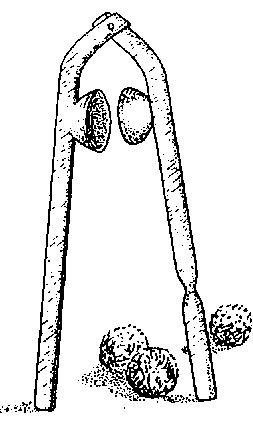
Another press which has been developed and tested consists of a square container in which waste is pressed by a screw similar to that in a wine press. Pressure is up to 2 tons per briquette or about 40 kg./cm.2. The rate of production, however, is slower than with the lever press.
Good results have been obtained by adapting these presses for bricks or earth blocks. They are now well known in developing countries under such names as "Cinva-Ram," "Terstaram," and "Combustaram."
In Europe during World War I, screw-type briquette presses worked on the same principle as meat-cutting machines. They produced a continuous briquette mass for cutting into sections. The screw press has much lower pressure than the piston press and consequently has limited application for waste which is easily convertible into briquettes resistant to crumbling.
Advanced industrial presses for wood and agricultural waste exert much higher pressures, ranging from 1,000 to 1,200 kg./cm.2. At these pressures, the temperature is very high. Both high temperatures and high pressure destroy the elasticity of the wood, making it possible to form the briquettes without a binder.
Waste Preparation
The first operation, common to all briquette-making processes, is the chopping and/or grinding of combustible waste. In simple village technology, where the materials to be prepared are branches, twigs and straw, the best tool for chopping is a hatchet or broad axe. For production on a large scale, different tools are required such as the straw chopper commonly used by European farmers.
The second operation is the drying of the main combustible ingredients. In a simple technology, drying should be performed without the use of fuel. The only real option, therefore, is natural drying in well-ventilaged places protected from rain. Such drying takes a long time, so the basic ingredients for briquetting should be prepared well in advance.
Third comes the mixing of various kinds of waste and binding materials in order to produce the optimum consistency and heat value. If used motor oil is available, it may be added to the waste, but, although it increases the heat value of the briquettes, it makes them crumbly.
The fourth operation is compressing the briquettes, and the fifth is drying them in open air, under shelter. Depending upon the binding material and drying conditions, it will take between a few and several months to produce dry briquettes. Drying significantly increases the heat value of the briquettes and thus saves fuel. They should therefore be produced well in advance of intended use.
New Types of fuel
Experience has shown that the successful implementation of new technical projects depends on socio-cultural, historical and economic factors as well as on purely technical ones. Many projects involving obvious technical improvements have failed because the non-technical factors were neglected.
When starting a new project, preliminary work on organization and research is essential before proceeding with technical design. The most effective way of achieving success is to assess the situation from several viewpoints.
On the basis of this inquiry, targets for the promotion of new fuels should be established. Costly and time-consuming surveys are not necessary. The environmental aspects should also be taken into consideration, because the combustion of biomass waste in stoves eliminates one of the important elements in the ecological chain. Under normal conditions, biomass waste is recirculated to the soil.
If this delicate equilibrium is broken, the consequences may be observed in decreasing productivity of the soil and, in extreme conditions, in its desertification.
Owing to the interdependence of fuel and stoves, it is recommended that stove and fuel improvement programs be undertaken concurrently. A combined program might consist of improvements to existing stove designs and fuel types to suit local cooking practices, and the design and construction of new stove models, together with the introduction of new types of fuel.
New briquettes should be tested. This is the only way to collect and compare the technical data of the various options available locally.
Field testing should be applied, both to develop or improve new fuels and to analyze their heat values. Groups of people from different backgrounds could be organized to investigate, promote, and later use the fuels in their households on an experimental basis. They should be invited to carry out further investigation on the composition of locally available biomass waste for briquetting and binding materials.
In most developing countries, there are considerable quantities of biomass waste which could be processed by means of agglomeration and densification. The best results are usually achieved if several kinds of material are mixed with a binder. The heat value of well-dried, compressed big-fuel waste is similar to that of fuelwood. However, the uncontrolled use of biomass waste could have adverse ecological consequences on the soil, such as reduced fertility. Careful evaluation of how much and which biomass can be used as fuel in specific regions should be undertaken and monitored by competent officials.
Table 1. Ignition temperatures of solid materials
|
Material |
Ignition temperature (°C) |
|
Lignite dust |
150-170 |
|
Hard coal dust |
150-220 |
|
Coke from lignite coal |
300-400 |
|
Coke from hard coal |
350-700 |
|
Graphite |
700-850 |
|
Charcoal (soft) |
250-300 |
|
Charcoal (hard) |
300-450 |
|
Peat |
200-450 |
|
Paper |
300 |
|
Wood dust |
315-460 |
Source: Author's measurements
Table 2. Net heat value of firewoods
|
Heat value |
|||
|
Seasoned |
Green |
Specific weight of dry wood |
|
|
kcal/kg |
kg/dm3 |
||
|
Pine (Pinus) |
4 658 |
3 870 |
0.49 |
|
Weymouth pine (Pinus strobus) |
4 876 |
4 055 |
0.37 |
|
Birch (Betula) |
4 658 |
3 869 |
0.61 |
|
Spruce (Pices) |
4 622 |
3 589 |
0.43 |
|
Larch (Larix) |
4 597 |
3 818 |
0.55 |
|
Fir (Ables) |
4 559 |
3 785 |
0.41 |
|
Locust (Robinia) |
4 527 |
3 760 |
0.73 |
|
Beech (Fagus) |
4 478 |
3 705 |
0.69 |
|
Linden (Tilla) |
4 474 |
3 713 |
0.49 |
|
Elm (Ulmus) |
4 419 |
3 810 |
0.64 |
|
Oak (Ouercus) |
4 329 |
3 742 |
0.65 |
|
Ash (Fraxinus) |
4 329 |
3 593 |
0.68 |
|
Alder (Ainus) |
4 288 |
3 555 |
0.49 |
|
Sycamore (Acer pseudoplatanus) |
4 245 |
3 845 |
0.59 |
|
Black poplar (Populus nigra) |
4 205 |
3 518 |
0.41 |
Source: T. Wojciechowski, Nouka e drawnie, PWRIL, 1961
Table 3. Materials used for the manufacture of briquettes
Paper waste
Municipal waste
Wood waste
Coconut fibre
Peat
Tundra dust
Cotton waste
Sawdust
Straw
Groundnut shells
Hazelnut shells
Olive-oil residue
Sugar cane
Bark
Rice husks
Sunflower husks
Leather waste
Hemp
Manure
Used motor-oil (as an additive to solids)
Hay
Shrubs
Fish waste
Food processing waste
Table 4. Comparison of sample bio-fuels
|
Composition |
Gross heat value |
Humidity |
Ash |
Net heat value |
Comment |
|
kcal/kg |
Percent |
kcal/kg |
|||
|
Dry beech wood |
4 554 |
8.0 |
0.3 |
4 224 |
Type of wood rarely available in poor rural areas |
|
Green birch wood |
3 308 |
42.9 |
0.25 |
2 889 |
Type of wood commonly found in poor rural areas of developing countries |
|
Waster-paper balls (made from soaked newspaper) |
4 143 |
6.9 |
2.9 |
3 825 |
Made by hand; burn better if wood ash is added |
|
Briquettes made of 30-45% charcoal dust 30-45% chopped twigs 15-20% manure |
4 626 |
2.4 |
32.2 |
4 408 |
Comparable to medium-quality hard coal; high ash content probably from sand |
|
Briquettes made of 25% charcoal dust 25% straw 30% chopped twigs 20% manure |
3 397 |
7.2 |
13.7 |
3 109 |
Lower percentage of charcoal dust reduces heat output |
|
Briquettes made of 50% straw 50% cow manure |
3 898 |
5.4 |
9.5 |
3 599 |
Feasible everywhere, but has high manure content - and manure is better used for fertilizer |
|
Briquettes made of 40% straw 40% sawdust 20% manure |
3561 |
9.2 |
14.0 |
3 266 |
Needs careful drying because os sawdust |
|
Briquettes made from charcoal dust with clay as binder |
3064 |
- |
975 |
High mineral content lowers heat value and creates much ash |
|
A national corporation was set up by an African country to manage a natural forest using the income from forest products to finance its management operations. The forest chosen for management had been degraded over the years by grazing and wild fire. The surrounding villages had historically been given free use of this land which was now declared reserved forest.
One of the major products available from this forest was charcoal. The corporation used earth kilns for production and the yields were good. The labor force was recruited locally allowing some return to the surrounding villages.
After a few weeks of production, it was discovered that about 10% of the charcoal was remaining behind in the soil after carbonization. The small particles could be recovered by flotation, but were too fine to be sold on the domestic market. The corporation decided to set up a briquetting operation.
Preliminary investigation uncovered two options for setting up the operation. The corporation could import both equipment and resin binder from Europe and produce briquettes "in-house." Or, they could set up the production as a local cottage industry using village labor, tree gums gathered from the area, and simple techniques which would produce briquettes comparable in quality and cost to the in-house briquettes. It was also found that the briquetting work would fit into the local agricultural work-schedule and provide another source of income to the villages.
The corporation decided to make the briquetting a cottage industry. They designated charcoal recovery areas for each village, provided basic training, and bought the finished briquettes from the villagers at a mutually agreed-upon price.
The final result was a saving of investment capital by the corporation and a firmly established local industry. The cooperative effort was then expanded into different fields.
This technique was developed at the request of Peace Corps Mali to transform millet stalks into an easily transportable energy source. The best use of most agricultural waste is to return it to the soil, but if this is not technologically or socially possible, most agricultural waste can be carbonised or used directly for fuel, preferably in improved cooking stoves. Carbonising reduces the bulk of the fuel, preserves fuel from insects and fungus, facilitates storage, and provides a smokeless fuel for use in densely populated areas.
In the Bamako tests, millet stalks were carbonised in an oil drum kiln. This takes 2 to 3 hours of labor per day. The resulting charcoal is-fluffy and fiberous and is easy to form into briquettes. The charcoal is lightly pounded to reduce bulk, and non-carbonised pieces are then picked out. The powder is placed in a container of 20 to 40 liters and binder is added.
The binders used in Bamako were gum arabic and clay. Due to the fiberous nature of the charcoal produced from millet stalks, briquettes using no binder at all were also successfully produced, but they break down from rough handling and disintegrate more rapidly when burning. Using clay only produced a briquette with sustained heating properties, but is was hard to keep going and left a ceramic residue which blocked heat from below. Gum arabic binder produced a briquette which held together well and was quite satisfactory. Gum arabic with a small amount of clay produced the best briquette. The addition of clay extended the burning time and gave a denser briquette. The binder was prepared by dissolving gum arabic in water and adding it to the charcoal, along with enough clay and water to make the mixture rather stiff. Inch and a half plactic pipe was used to form the briquettes by jabbing the pipe up and down in the mix until the pipe was forced full of the mixture. The pipe was then removed and held at a slight angle to the ground. A push rod of slightly smaller diameter was inserted to push out the mix. The actual maneuver is more like holding the mix with the push rod and sliding the pipe off of the mix. This can be done directly on the ground or on mats, and should be exposed to the sun. The resulting long sausage can be left to partially dry if necessary. If the mix is correct, it can immediately be broken into small segments on 2 to 3 cm. thickness and each briquette placed on its side to dry. In Bamako, during May, the briquettes were sufficiently sun dried in two days to burn well and were easily handled without breaking. One batch was caught in a heavy rain after one day of drying but remained stable, even though they required an additional two days of drying. None of the briquettes gave off objectional odors when burned and user acceptance was good.
A binder is simply something which holds the charcoal briquette together while it is being moved about or while it is burning. Briquettes can be made without binder if the charcoal itself is of a fluffy nature, as in some types of charcoal made from agricultural wastes. But, these briquettes will tend to fall apart as burning takes place, and they certainly won't stand up to rough handling.
Adhesiveness is the most basic and important quality to look for in a binder. However, some of the most adhesive binders may be uneconomical or unacceptable to the user. Some possible binders are:
tar
starch
plant resins
commercially prepared resins
clay
animal manure
fish waste
molasses
In the US, the most commonly used binder is starch. In southern Senegal, the smell of burning starch is objectionable to the people and a local tree gum has been found that is acceptable. Clay will act as a binder, but the powdery residue blocks the passage of radiant heat, and much of the heating value of the charcoal is lost. Briquettes prepared with tar or molasses have to be heat-treated to drive off the volatiles that have been added.
In addition to the binder, a carrier is needed to make a good mixture with the powdered charcoal. As this is usually water, the binder should tee wafer soluble, or at least emulsifiable in the case of oil-based binders. Some binders, such as fish waste or starch, will require precooking to make them sticky.
The usual formula for a briquette mix using starch is 100 kilograms of charcoal, 5 to 7 kilograms of starch, and 30 to 35 kilograms of water. Starch can be obtained from roots or grains, preferably those which do not serve as a source of food. Crush or grind the grain or root and wash the starch from the crushed residue. The starch is contained in the wash water and will settle to the bottom. If you catch a sample of the wash water in a clear glass container before the starch has had a chance to settle, you can calculate the necessary amount of water needed to cook and mix the starch. Measure the starch depth and multiply by 3.407. That is where the top of the water column should be. Water can then be added to or removed from the main container in like proportion. These proportions will give a mixture of starch and water that will gelatinize without becoming too thick. It should then be heated to 65°C, at which point it will thicken and can be mixed with the charcoal.
|
Total Time: |
2 hours |
|
Objectives: |
* To determine the moisture content of wood |
|
* To calculate the yield of a kiln |
|
|
Materials: |
Newsprint, felt-tip pens, pencils or pens, notebook paper, sample pieces of wood of varying moisture contents. |
|
Resources: |
* Attachment 19-A, "Elementary Calculation of Moisture Content" |
|
* Attachment 19-B, "Energy Potential of Raw Wood" |
|
|
* Attachment 19-C, "Charcoal Yield Worksheet" |
|
Trainer Notes * Prior to this session, it will be necessary to gather several pieces of wood from among common local varieties and calculate their moisture content. Number the samples and record their exact moisture contents on a sheet of paper. (See Step 4) * Also, it will be necessary to create and solve two hypothetical yield calculation problems. (See Step 8) |
Procedures:
Step 1. (5 minutes)
Explain the session objectives.
Step 2. (10 minutes)
Ask participants to briefly review and explain factors to be considered in evaluating different types of kilns.
|
Trainer Notes * Remind participants of the factors mentioned in the article, "Realities of Making Charcoal" and of the criteria lists which were developed in their design plans. * Some factors which should be mentioned include: - user needs - labor requirements - capital requirements - carbonization time - kiln capacity - portability - durability - availability of construction materials - ease of operation - yield * Point out that "yield" calculations are an important way of determining the specific energy efficiency of a particular kiln design. |
Step 3. (15 minutes)
Ask participants to identify some of the variables which should be considered in calculating yield.
|
Trainer Notes * Explain that yield calculation essentially involves comparing the amount of potential energy going into a kiln in the form of wood to the amount of energy potential coming out in the form of charcoal. * Stimulate discussion by asking: - What variables must be considered in determining the energy potential of raw wood? - What variables should be considered in determining the energy potential of charcoal? * Some important variables which should be highlighted include: - moisture content of raw wood - weight of raw wood - brands found in kiln - moisture content of charcoal |
Step 4. (15 minutes)
Distribute the samples of raw wood and have participants estimate the moisture content of each sample.
|
Trainer Notes * Record their estimates on newsprint. * Point out that different wood species have different densities, so weight alone may not indicate moisture content. The feel and smell of the wood are often more reliable indicators. * A game can be made of this activity by offering a prize to the participant who most accurately guesses the actual moisture content of a particular sample. |
Step 5. (5 minutes)
Reveal the real, calculated moisture content of each sample by writing it on the newsprint beside their estimates.
Step 6. (20 minutes)
Distribute Attachment 19-A, "Elementary Calculation of Moisture Content" and Attachment 19-B, "Energy Potential of Raw Wood" and practice calculating moisture content.
|
Trainer Notes * Allow participants time to look over the attachments and ask questions. * Explain that the oven-dry weight of a quantity of wood can be determined by baking random samples at below 212° centigrade until stable weight is obtained (usually overnight). * Identify individuals among the participants that are familiar with calculating moisture content and ask them to help others in the group to work a few sample problems using hypothetical weight figures. |
Step 7. (15 minutes)
Distribute and explain Attachment 19-C, "Charcoal Yield Worksheet."
|
Trainer Notes * Explain the basic formula outlined on the attachment by working through the sample problem on newsprint. * Mention that the moisture content of the charcoal is assumed to be negligible unless it has been wetted by rain or during the extraction process. If necessary, the moisture content of the charcoal can be determined by baking random samples. |
Step 8. (20 minutes)
Ask participants to practice solving two hypothetical yield problems.
|
Trainer Notes * Write two hypothetical problems on newsprint. * Ask those participants who work out the problems early to help others in the group who may be experiencing difficulty. |
Step 9. (15 minutes)
Conclude by asking participants to discuss examples of ways in which yield calculations could be helpful at their work sites.
|
Trainer Notes * Stimulate discussion by asking: - What difficulties would you encounter in collecting yield data at your work site? - How could these difficulties be overcome? - Why is accurate yield data important? |
In forestry it is customarily given as a percent fraction on a DRY basis:

Beware that we customarily think in terms of "percent of a total," in this case giving a WET basis figure which is NOT generally used:
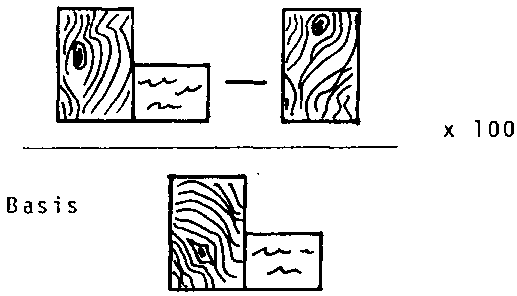
Raw Wood Charged
|
Air-dry wood |
Partially dry wood |
Wet wood |
|
25% m.c. |
50% m.c. |
100% m.c. |
|
Fig. 1 |
Fig. 2 |
Fig. 3 |
|
1. 25 kg |
1.5 kg |
2.0 kg |
|
4850 kcal |
4700 kcal |
4400 kcal |
|
Ranking |
|||
|
Very Good |
Fig. 4 |
Fig. 5 |
Fig. 6 |
|
0.35 kg. 35% yield |
0.30 kg. 2250 kcal |
0. 24 kg. 1800 kcal |
|
|
2625 kcal 54% of |
30% yield |
24% yield |
|
|
energy initially recoverable |
48% e.i.r. |
41 % e.i.r. |
|
|
Adequate |
Fig. 7 |
Fig. 8 |
Fig. 9 |
|
0. 25 kg. 1875 kcal |
0.20 kg. 1500 kcal |
0.15 kg. 1200 kcal |
|
|
25% yield |
20% yield |
16% yield |
|
|
39% e.i.r. |
32% e.i.r. |
27% e.i.r. |
|
|
Very Bad |
Fig. 10 |
Fig. 11 |
Fig. 12 |
|
0.15 kg. 1125 kcal |
0.10 kg. 750 kcal |
0.08 kg. 600 kcal |
|
|
15% yield |
10% yield |
8% yield |
|
|
23% e.i.r. |
15% e.i.r. |
14% e.i.r. |
Fig. 2 Energy Available from Raw Wood and from the Charcoal
Produced from It with Respect to Moisture Content and Efficiency of Carbonization

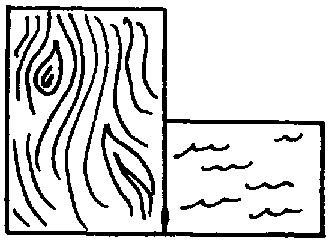
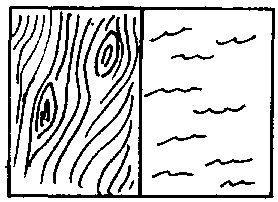









The basic formula for determining yield is:
![]()
Brands may be of two types: wet and oven-dry. Brand content of 2% or more by volume is an immediate indication of kiln inefficiency.
There are essentially four options in accounting for brands in yield calculations:
1) Subtract wet brands from wet wood, then calculate oven-dry wood weight.
2) Subtract dry brands after calculation of oven-dry wood weight.
3) Do both of the above.
4) Ignore the brands in the calculation and list x% yield with x% of brands.
Option #3 is generally considered to be most accurate.
|
Sample Problem: |
Work Space |
|
875 kilos of charcoal |
|
|
100 steres of wood at 350 kg. per stere |
|
|
8 kilos of wet brands |
|
|
4 kilos of dry brands |
|
|
20% moisture content (ODB) |
|
Total Time: |
2 hours |
|
Objectives: |
* To evaluate the effectiveness of the training program |
|
* To identify ways in which future charcoal training programs can be improved |
|
|
Materials: |
Newsprint and felt-tip pens |
Procedures:
Step 1. (10 minutes)
Review and explain the session objectives.
|
Trainer Notes * Remind the participants of the design principles which were discussed during the session on re-design of kilns (Session 13, Day 3). Point out that the principles of testing, evaluation and re-design also apply to the development of effective training programs. * Explain that evaluation through feedback from participants can serve as the basis for improving future charcoal training programs. |
Step 2. (25 minutes)
Have the participants divide into groups of 3 or 4 and record on newsprint their observations regarding the effectiveness of the training program.
|
Trainer Notes * Ask that each group list three aspects of the program which were particularly effective and three aspects which were particularly ineffective. * For each ineffective aspect of the program, ask that participants suggest ways in which it could be improved. * Encourage participants to be as specific as possible and to consider all aspects of the program (i.e., sequence of sessions, content of sessions, trainer techniques, etc.). * If possible, the trainers should join the small groups and participate in the activity. * While the small groups are working, arrange chairs in a semicircle at the front of the room so that three people can face and speak to one another while reading the posted observations and suggestions. Arrange a second row of chairs around the first three. The configuration should look like this:  Row of chairs * Approximately five minutes before the end of the time allotted for this step, circulate among the groups, remind them of the time remaining and ask that they post their observations and suggestions when they are finished. |
Step 3. (10 minutes)
Have the group reconvene and occupy the chairs the outer semi-circle. Explain the "Fishbowl" activity.
|
Trainer Notes * Ask if anyone has had experience with this activity. If so, ask them to help you with the explanation. Your explanation should include the following points: - Only three people at a time will be in the inner semi circle - The role of each of the three people will be to discuss and respond to the posted observations and examine the feasibility of the suggestions. - The role of those in the outer semi-circle will be to observe and listen without speaking. - When someone from the outer circle wants to enter the discussion, a person from the discussion group should leave and join the observers. * The reason for using the fishbowl structure is to provide a comfortable format for discussion and to encourage constructive feedback and suggestions. Therefore, it is important that people feel free to express their thoughts without fear of reprisal. People should be encouraged to enter the discussion and to exchange places with one another when they have something to say. It is a good idea to have at least one member of the training staff in the discussion group at all times. |
Step 4. (10 minutes)
Just before the discussion, ask one of the participants to scan the lists and point out any commonalities and parallels among the observations.
|
Trainer Notes * This quick identification will help provide order and avoid repetition once the discussion begins. |
Step 5. (50 minutes)
Ask that three volunteers move to the inner semicircle and initiate the activity by responding to one of the observations.
Step 6. (10 minutes)
Summarize the observations and suggestions for improvement that resulted from the fishbowl discussion.
|
Trainer Notes * Stress those observations which seem most generally agreed upon by the group and most feasible in terms of future implementation. |
Step 7. (5 minutes)
Thank the group for their participation in this activity and in the training program.
|
Trainer Notes * It is suggested that a barbeque be held immediately following this final session. Participants and staff could then have the opportunity to prepare a meal using charcoal produced during the program. |
We suggest that the following texts be purchased in sufficient quantities for distribution to all participants:
Booth, H. E.: "Realities of Making Charcoal." UNASYLVA, Vol. 33, No. 131, FAO, Rome.
Eckholm, Erik: The Other Energy Crisis: Firewood. World Watch Institute, Washington, DC, 1975.
Janczak, Jacek: "Simple Techniques for Basic Bio-fuels." UNASYLVA, Vol. 33, No. 131, FAO, Rome.
Noronha, Raymond: "Why is it So Difficult to Crow Fuelwood? UNASYLVA, Vol. 33, No. 131, FAO, Rome.
Salem, Ben B.: "Fuelwood Production in Traditional Farming Systems." and Tran van Nao UNASYLVA, Vol. 33, No. 131, FAO, Rome.
The following resources are effective for reference:
Earl, D. E.: Charcoal, an Andre Mayer Fellowship Report. FAO, Rome, Italy, 1974.
The only general charcoal publication in print. Emphasis is on the Mark V portable steel kiln.
Earl, D. E.: Forest Energy and Economic Development. Clarendon Press, Oxford, 1975.
An overview of forest energy and its role in economic development.
DEVRES: The Socio-Economic Context of Fuelwood Use in Small Rural Communities. Agency for International Development, Washington DC, 1980.
International Labor Organization: Charcoal Making for Small Scale Enterprises. Geneva, 1975.
Published in simple language for small scale producers in developing countries. Also covers the small business aspects of charcoal making. Emphasis is on metal kilns.
National Academy of Sciences: Firewood Crops. National Academy Press, Washington, DC, 1980.
Description of shrub and tree species For energy production, including carbonization possibilities.
US Forest Service: Charcoal Production, Marketing and Use. Washington, DC, Forest Products Research Lab Report 2213, 1961.
Information on masonry kilns.
THE FARALLONES INSTITUTE RURAL CENTER
15290 Coleman Valley Road
Occidental, CA 95465
(707) 874-3060
The Farallones Institute is a non-profit organization active in the development of appropriate community technologies, with an emphasis on renewable sources of energy and food systems. Areas of expertise include:
- design and implementation of training programs, with a focus on experiential learning and the acquisition of integrated skills
- development of educational materials
- resource gathering and information sharing
- design, use and evaluation of small-scale technologies
- study trips to rural China
- consulting services
CHP INTERNATIONAL, INC.
1010 West Lake Street
Oak Park, IL 60301
(312) 848-9650
CHP International, Inc. is a consulting firm specializing in the design, management and evaluation of international training programs. It develops and conducts technical, cross-cultural and language programs in Latin America, Asia, and Africa. In addition, CHP International, Inc. leads staff development workshops in the techniques necessary to effectively implement competency based and experiential training programs.
GPO 894-395